
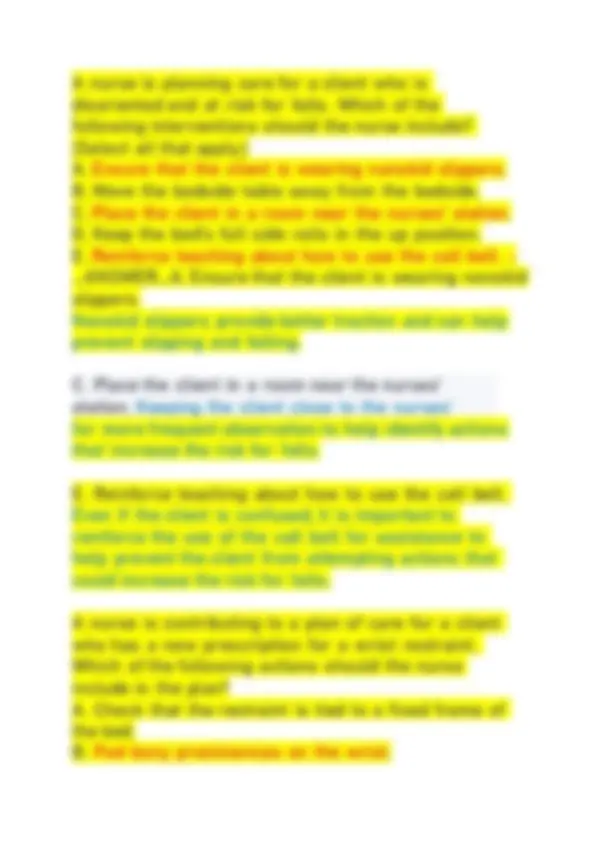
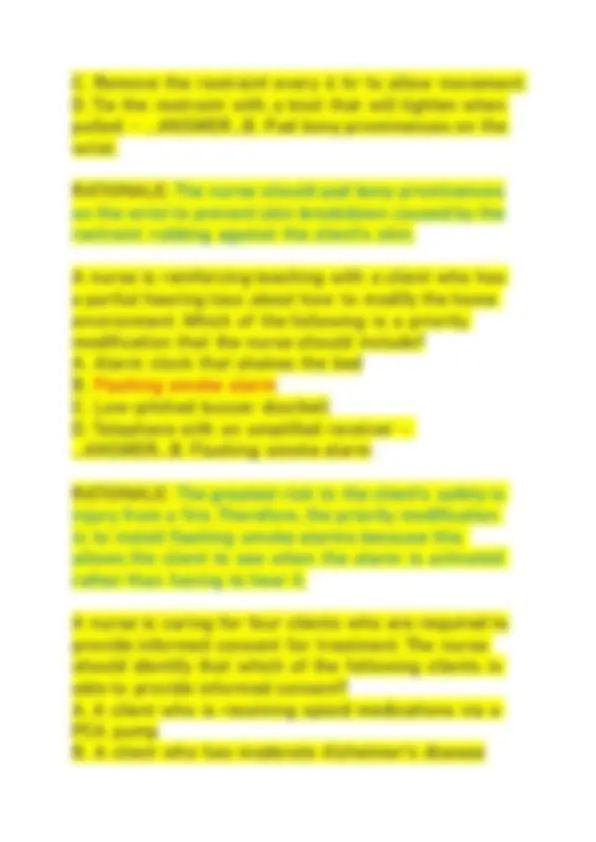
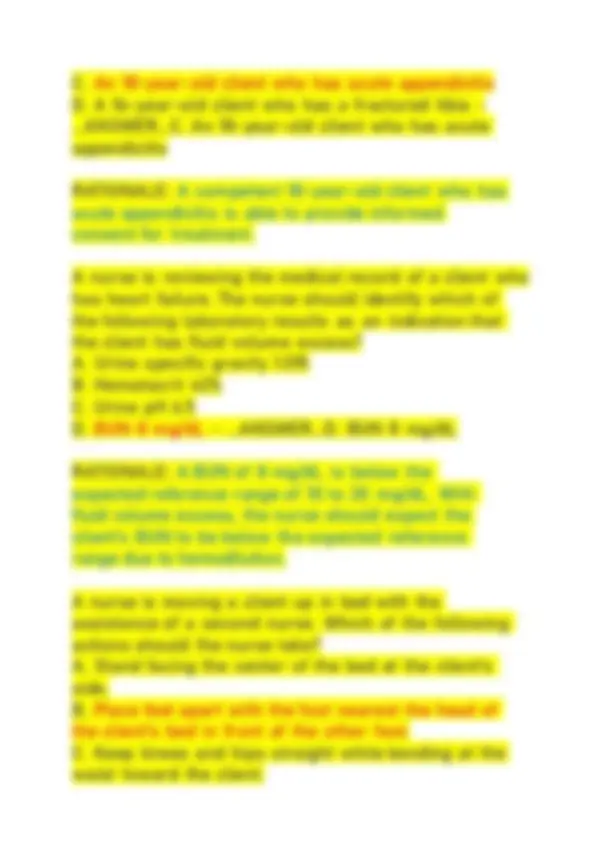
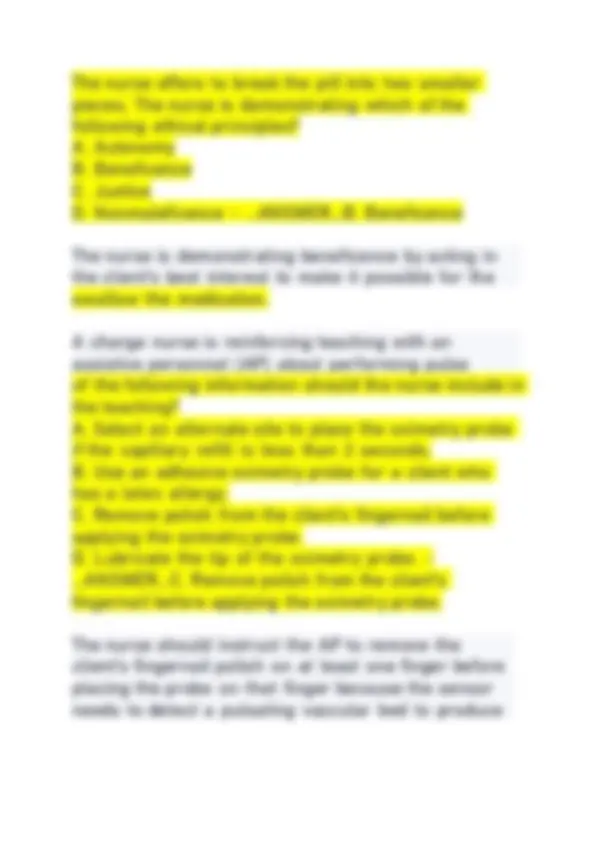
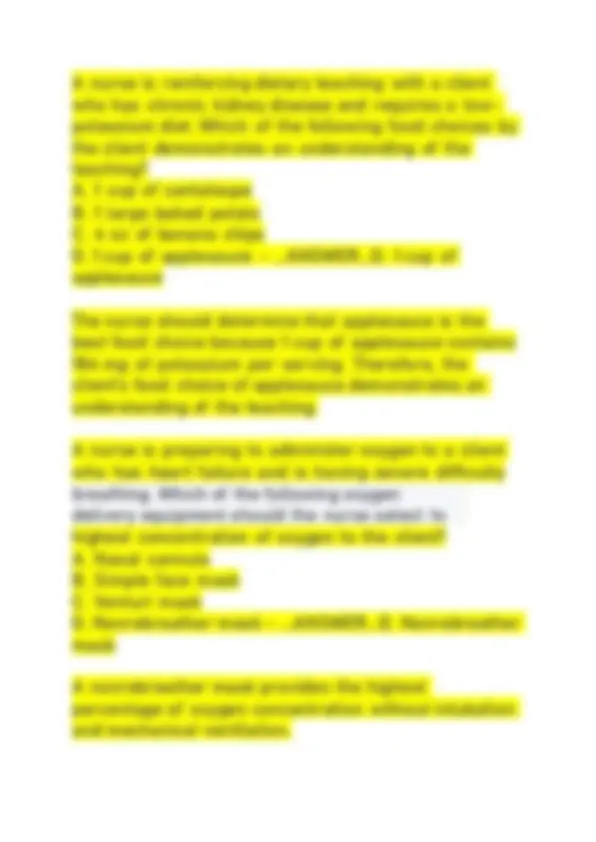
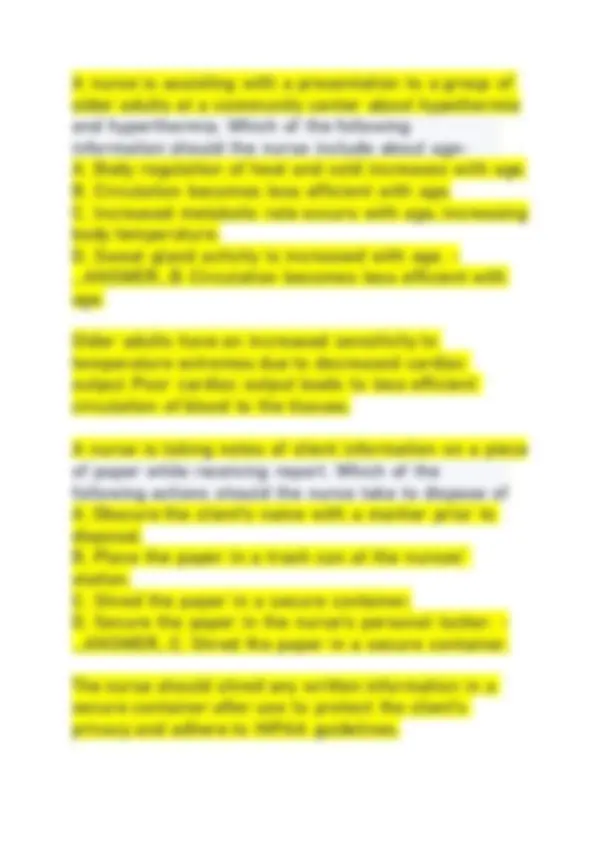
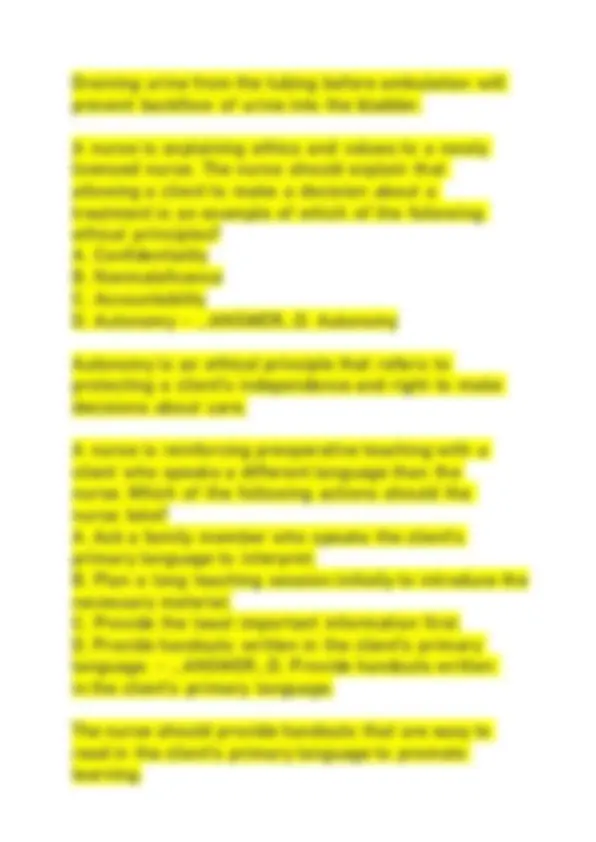
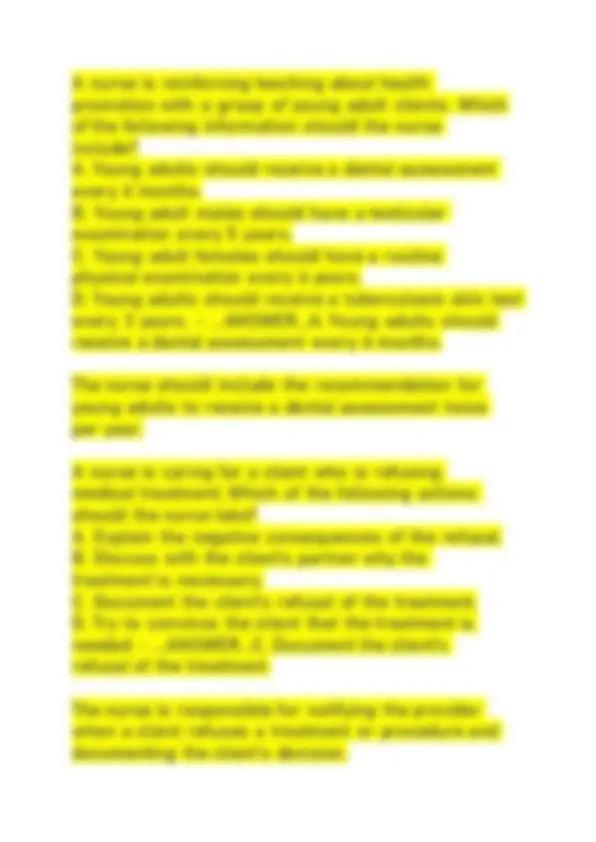
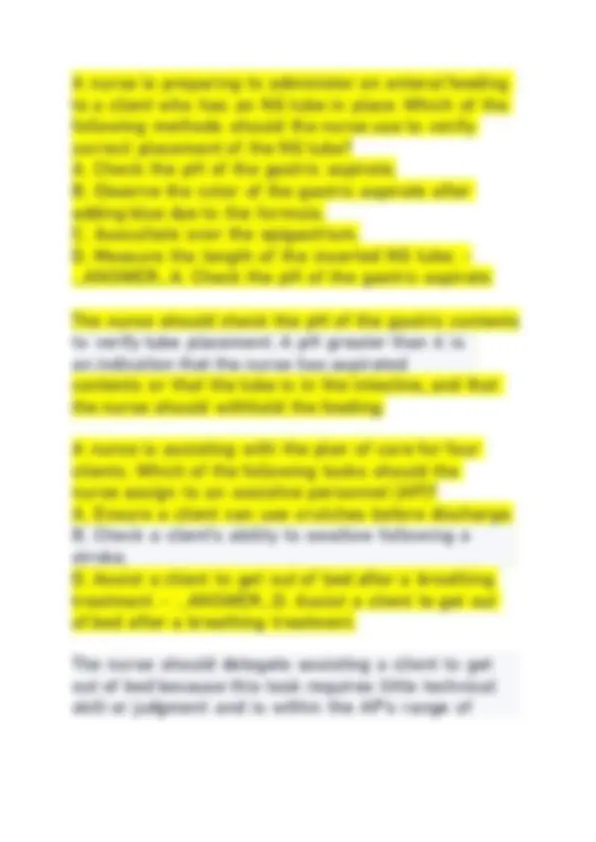
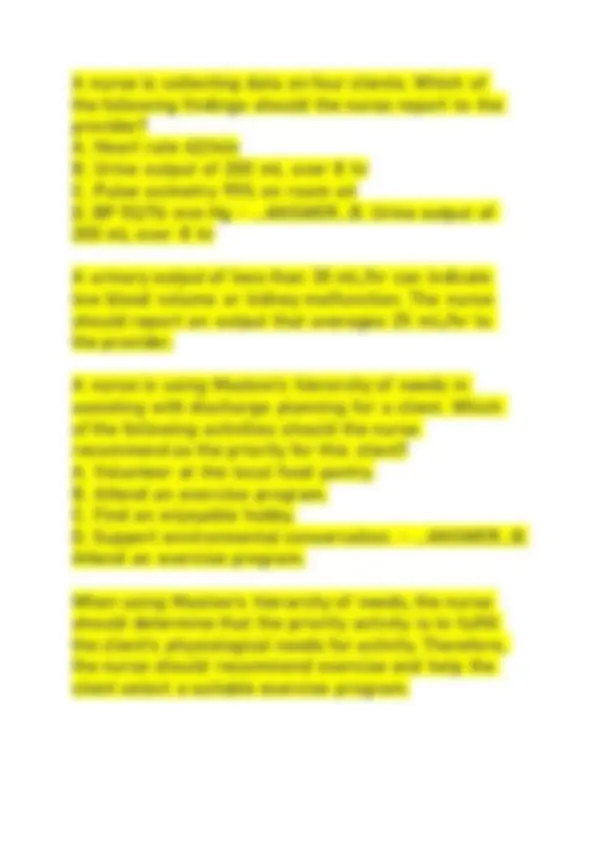
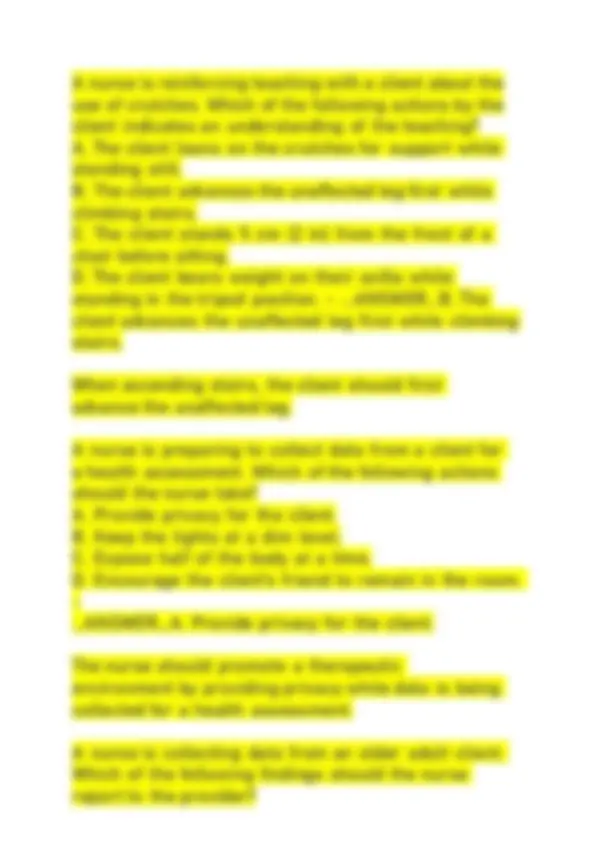
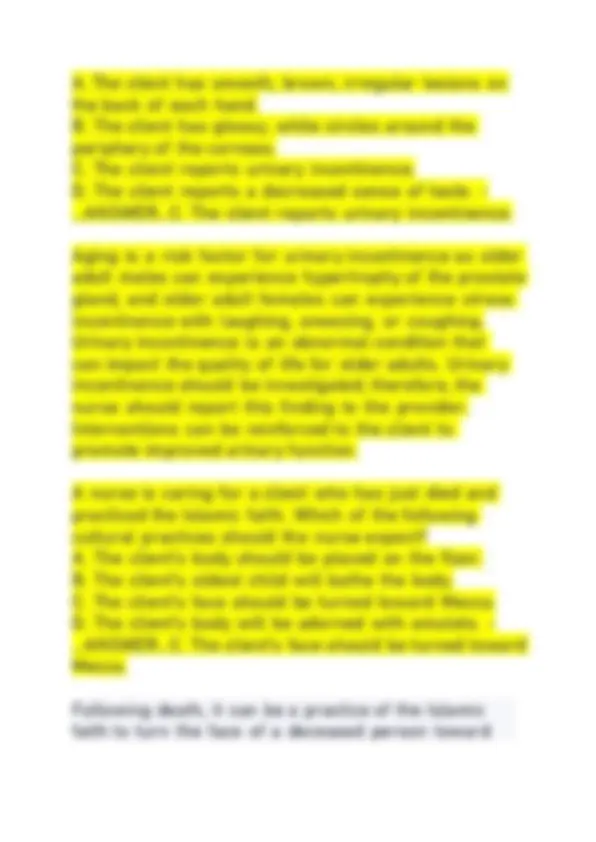
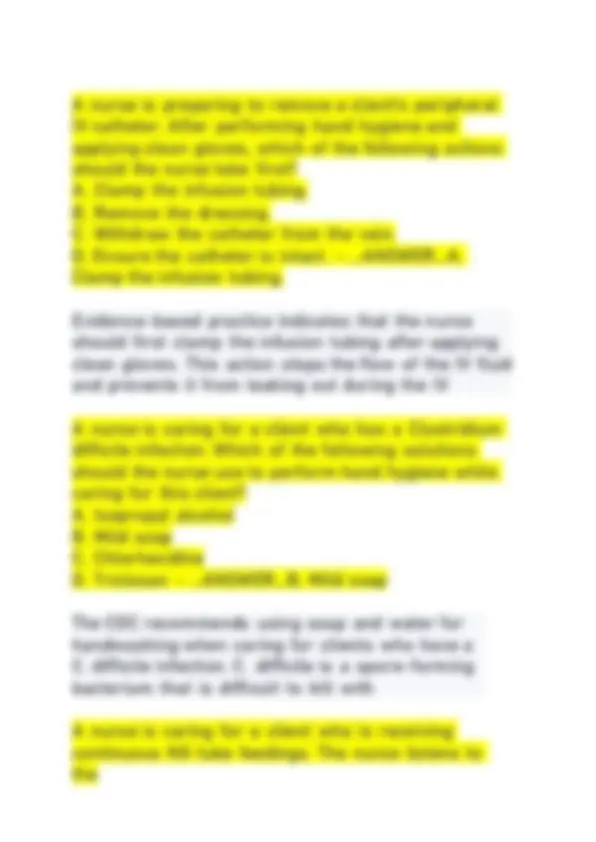
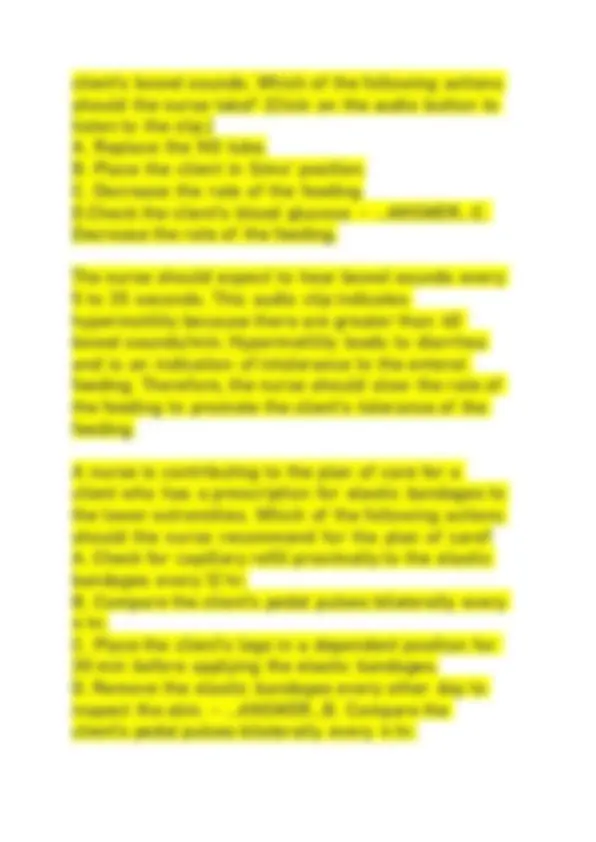
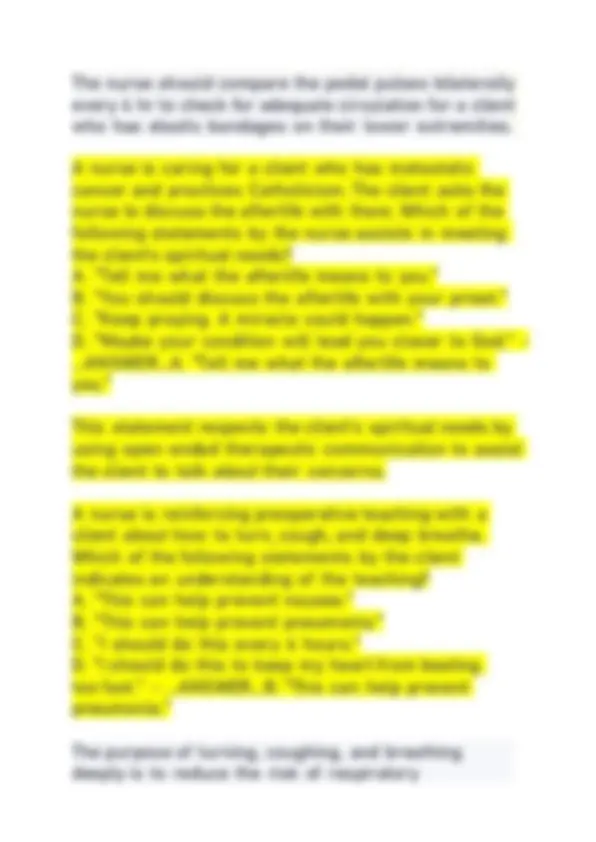
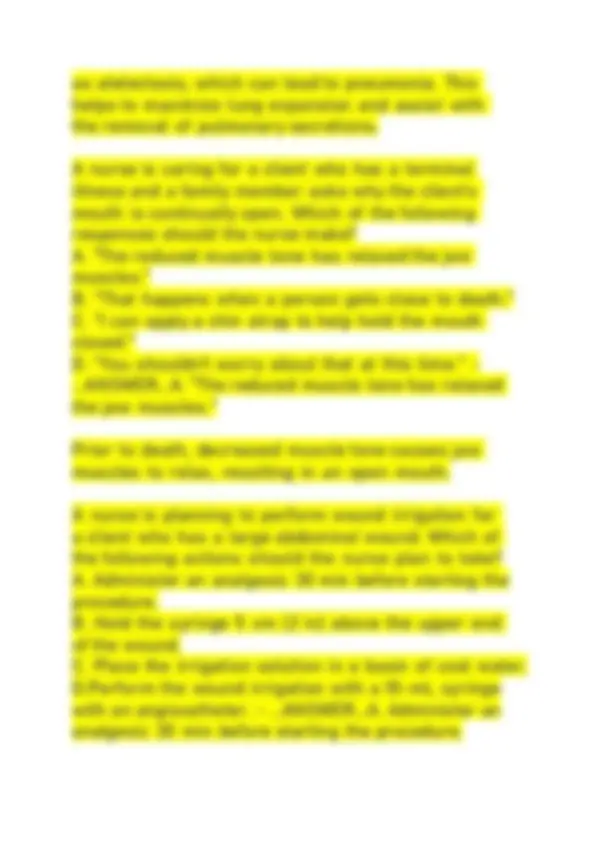
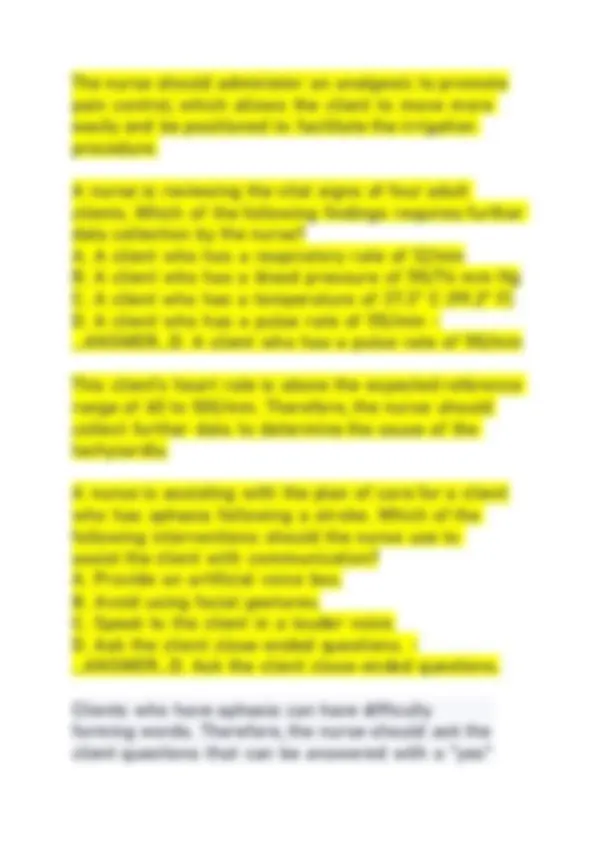
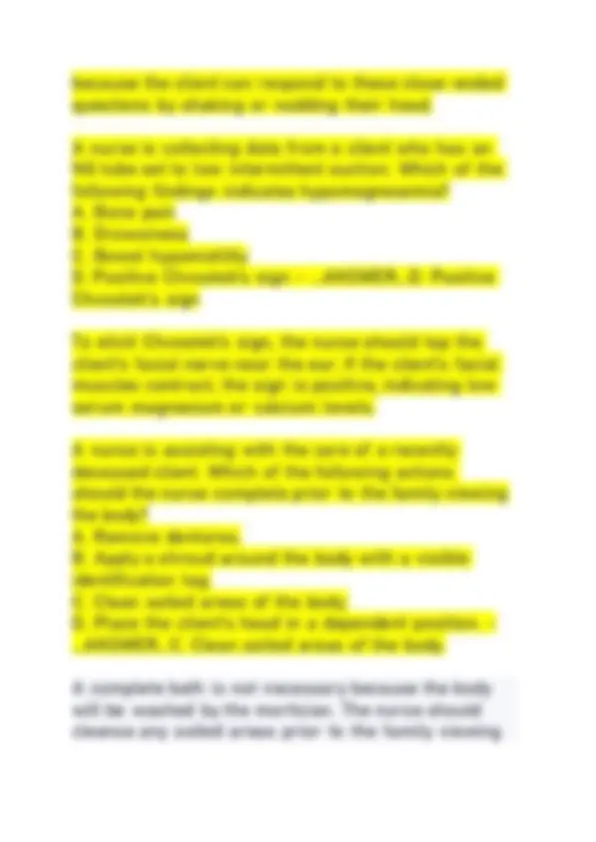
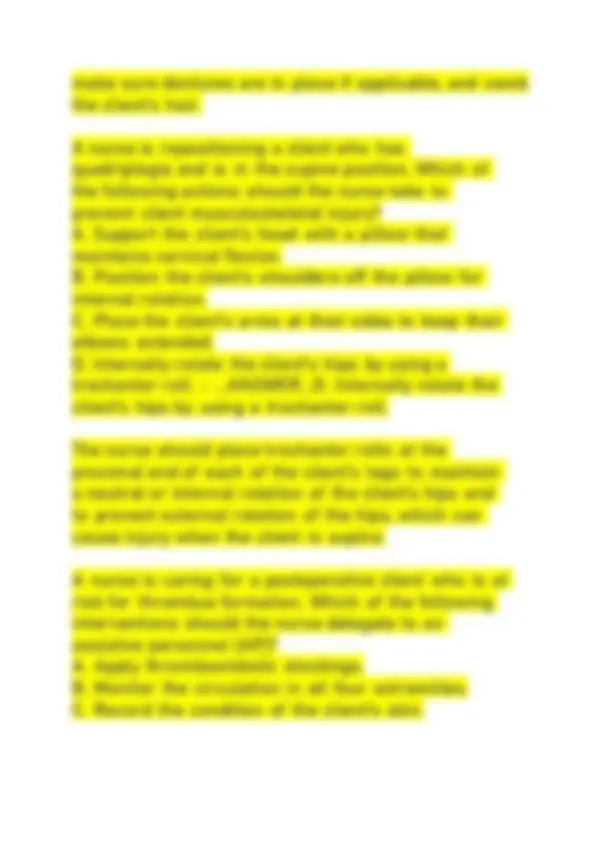
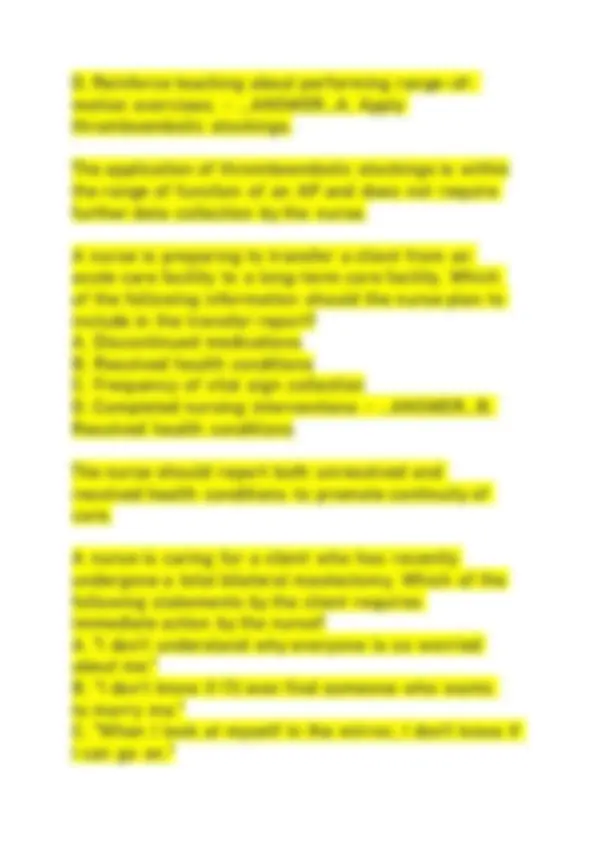
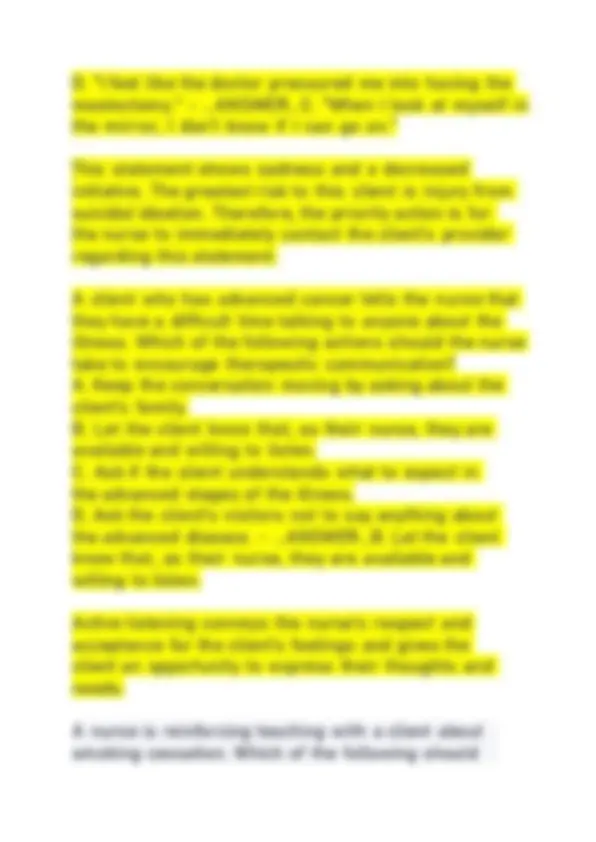
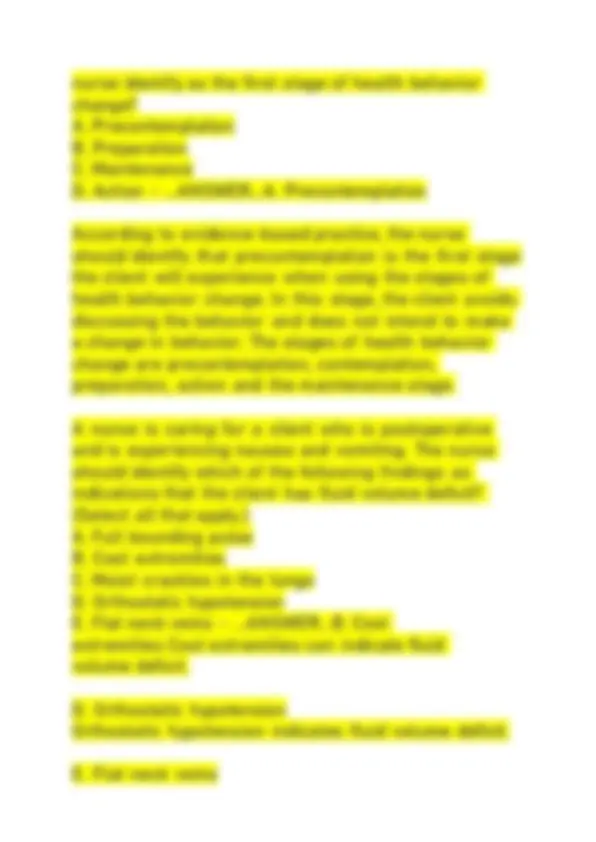
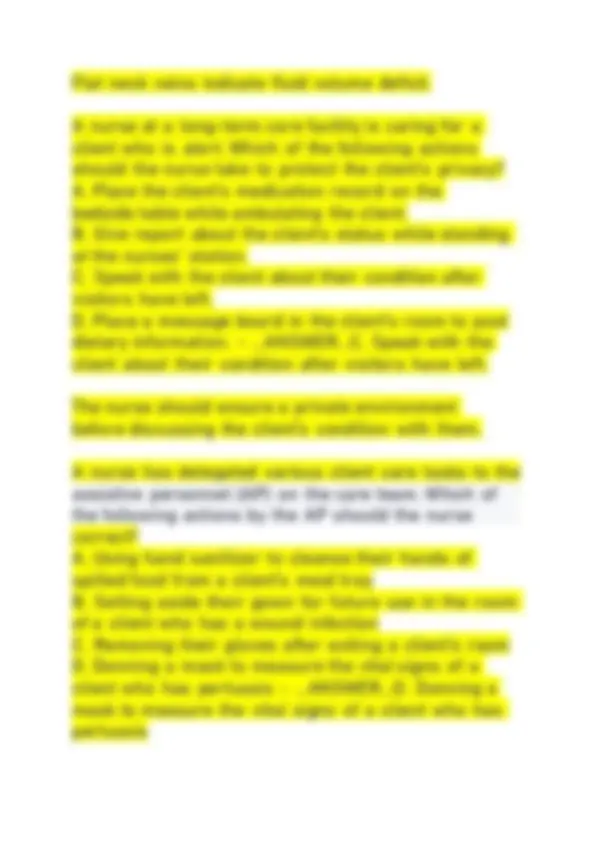
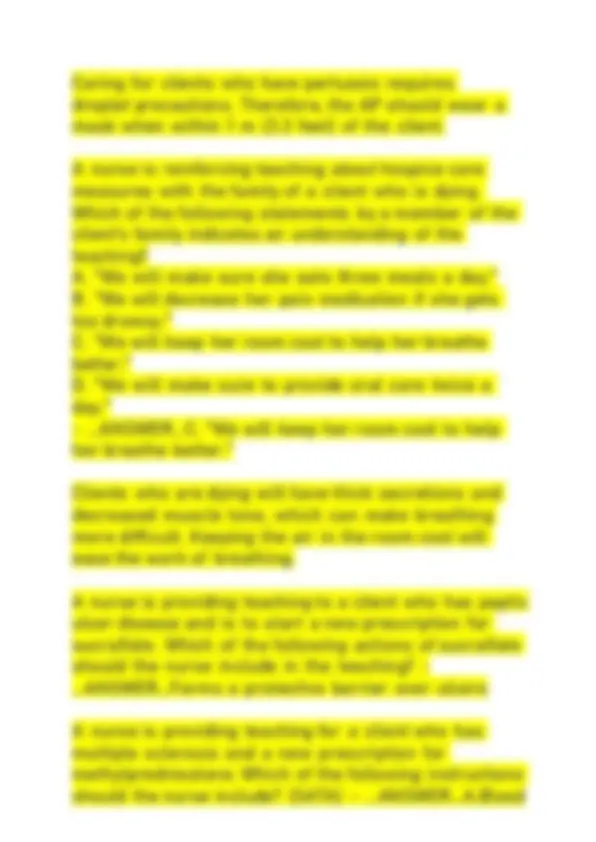
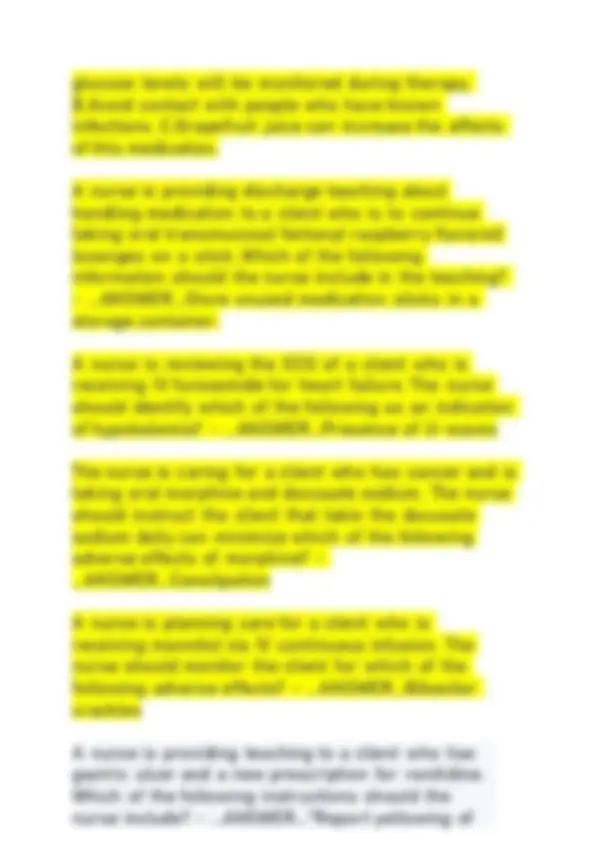
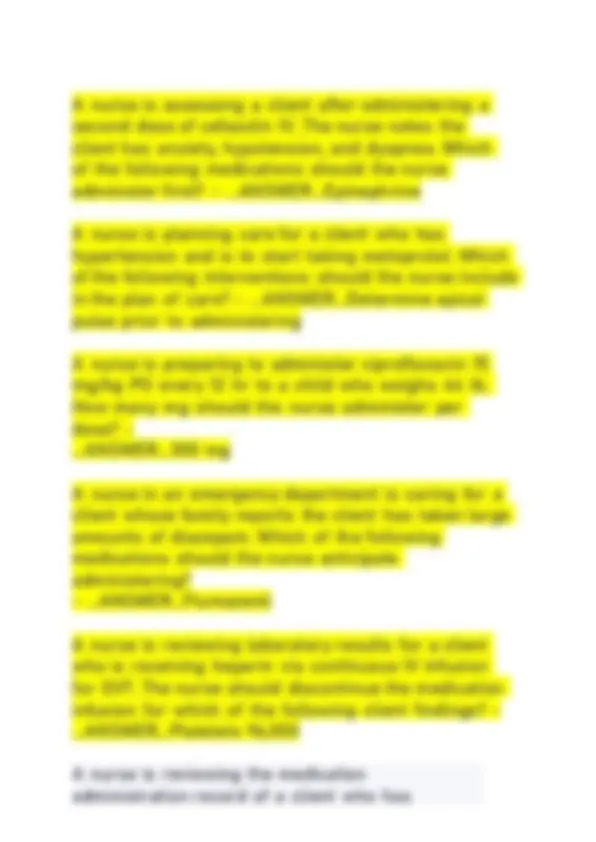
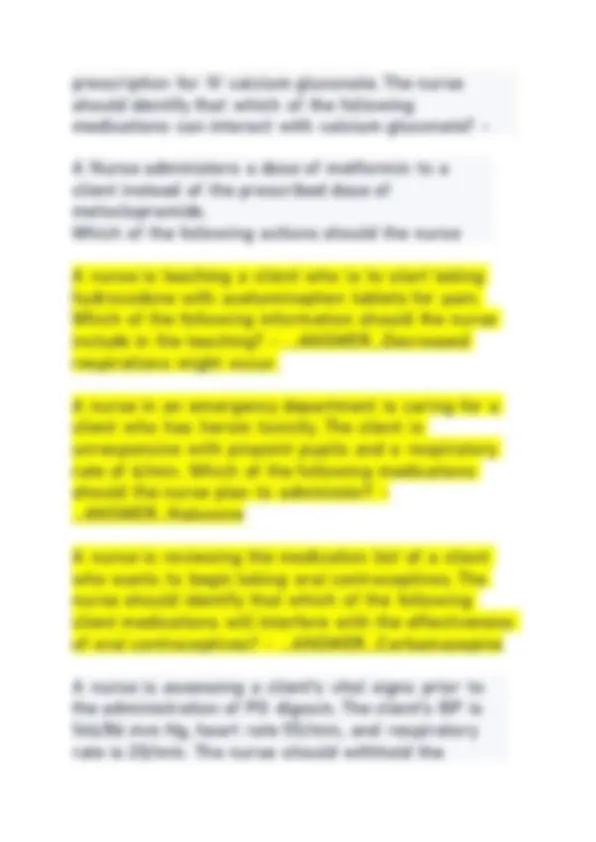
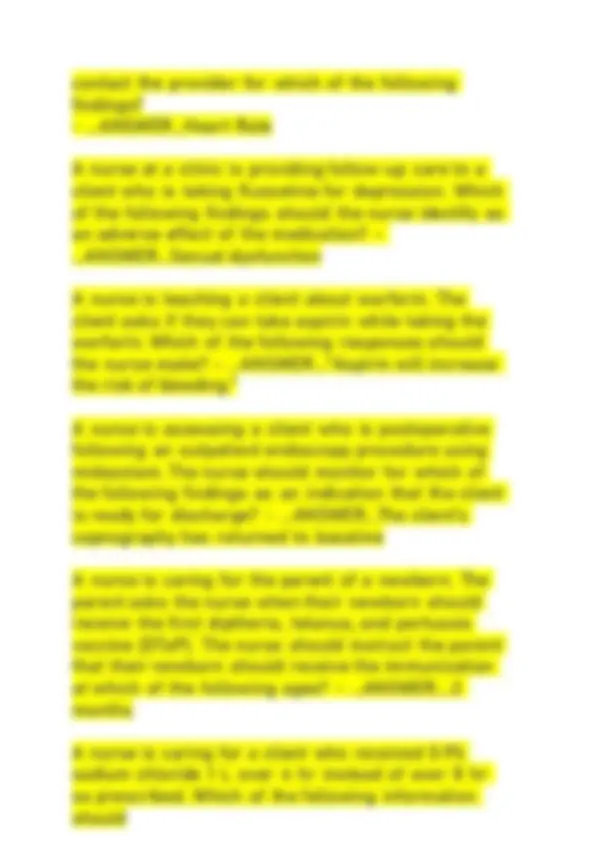
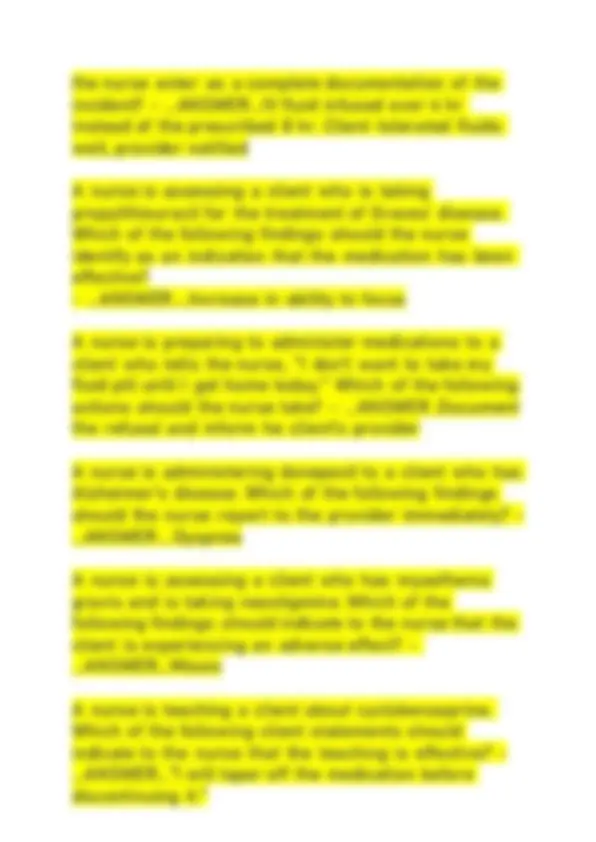
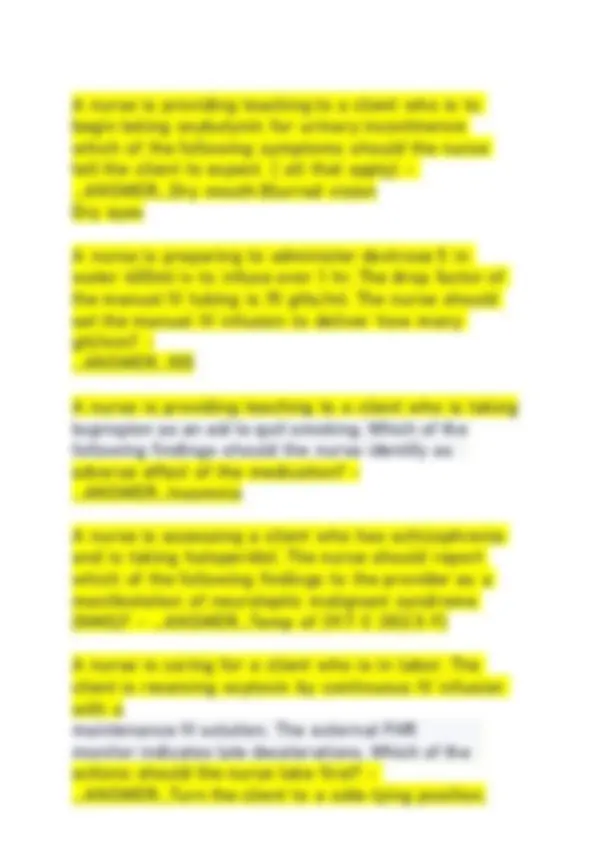
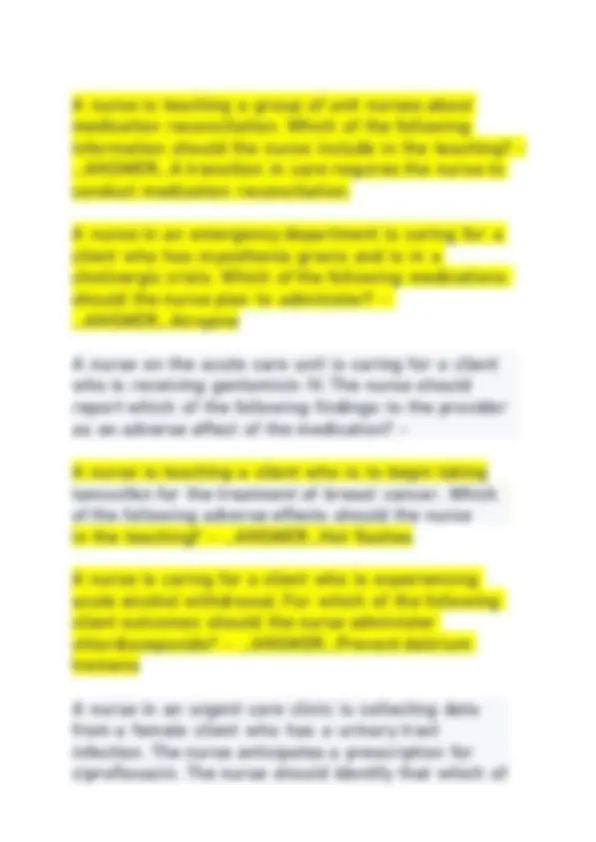
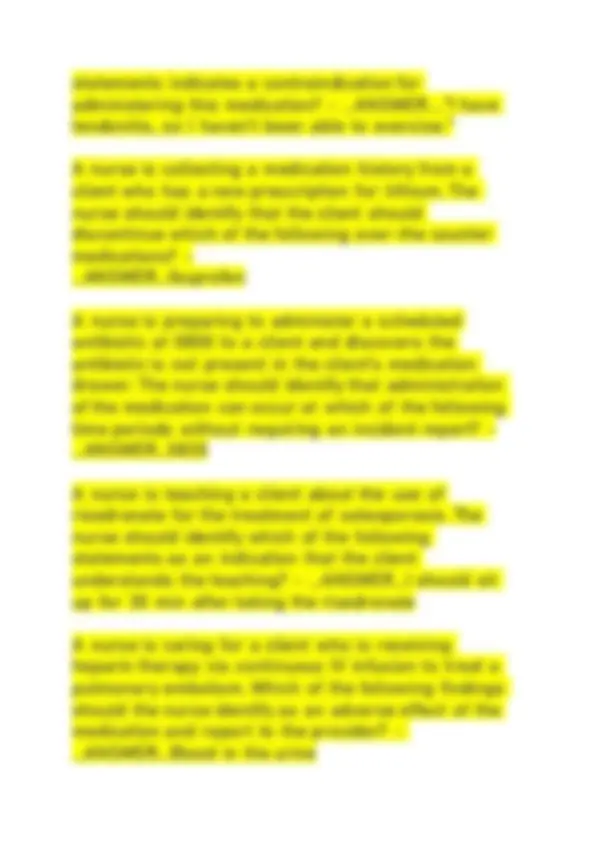
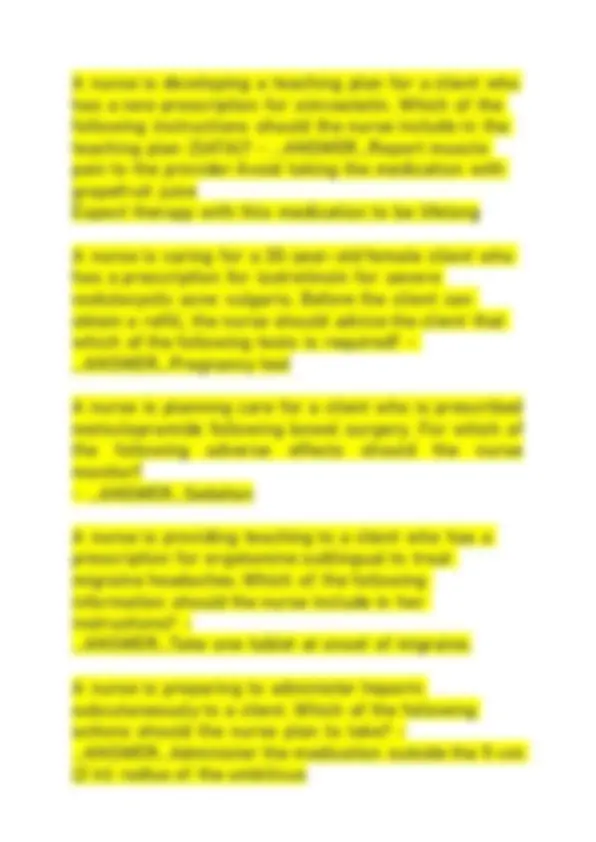
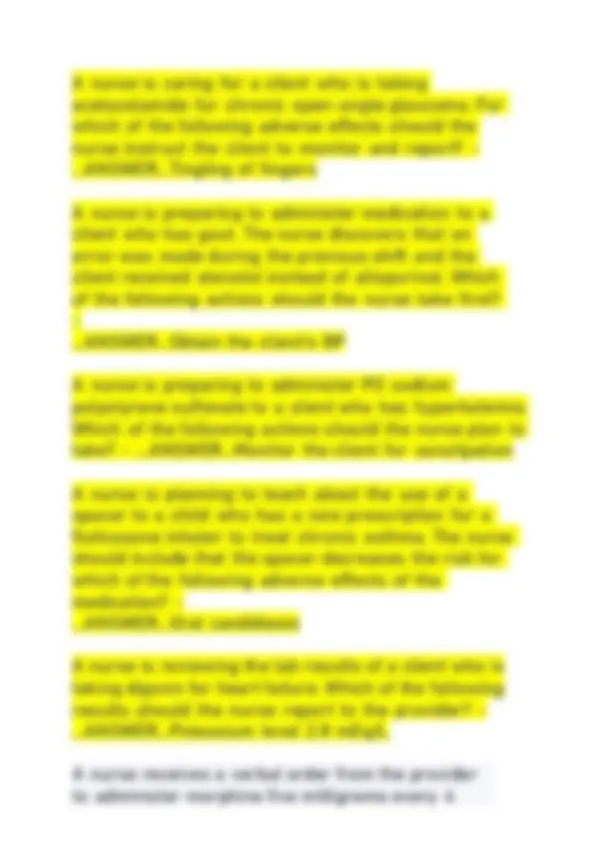
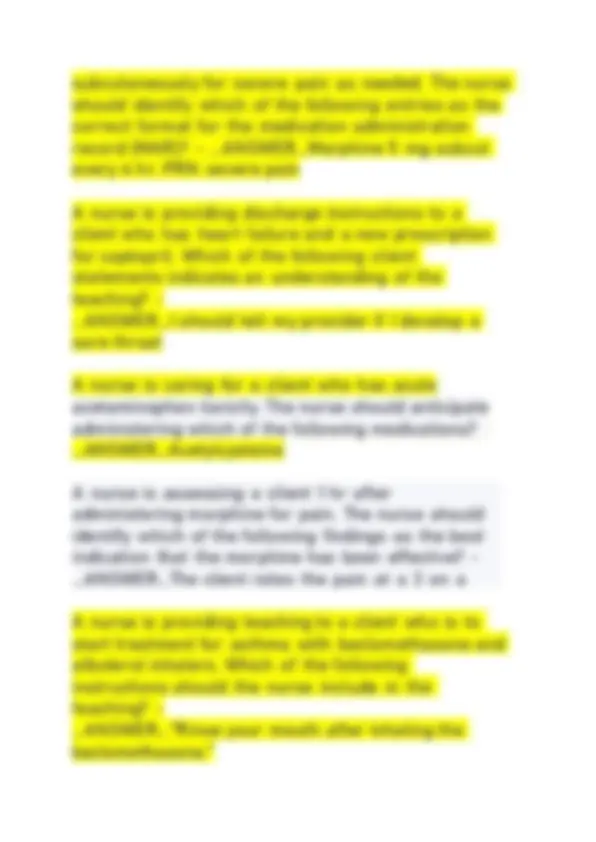
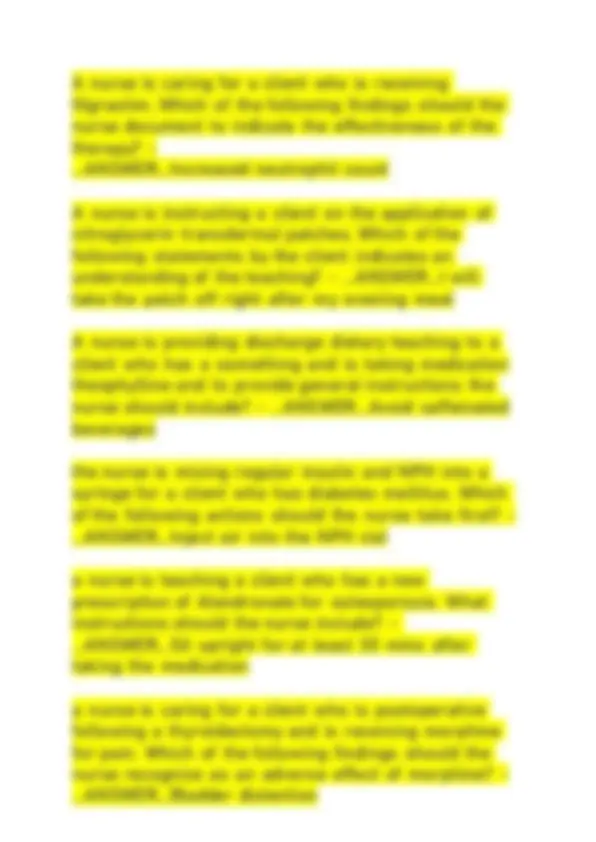
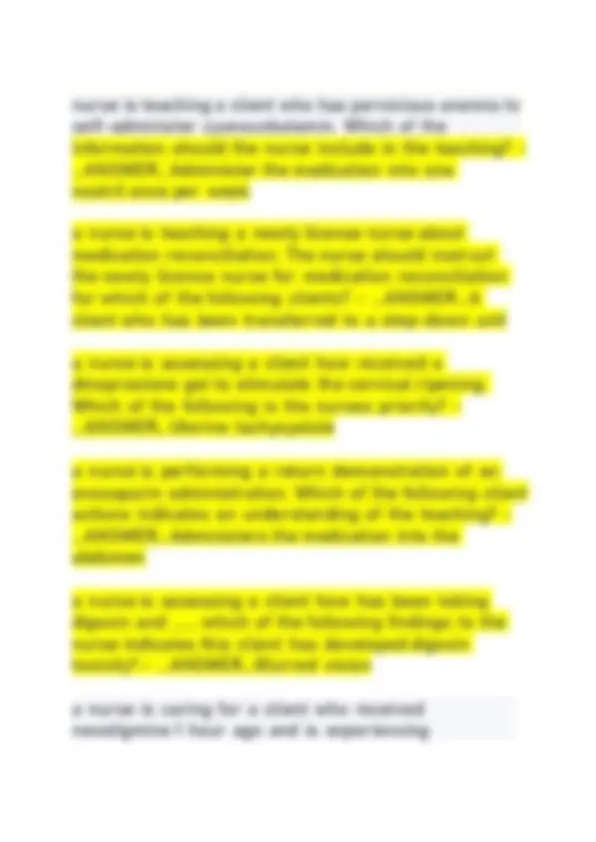
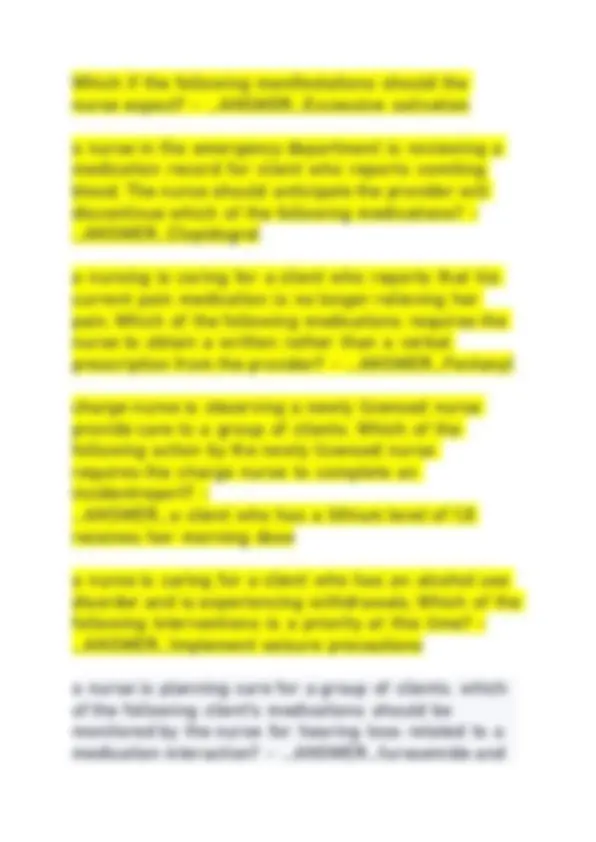
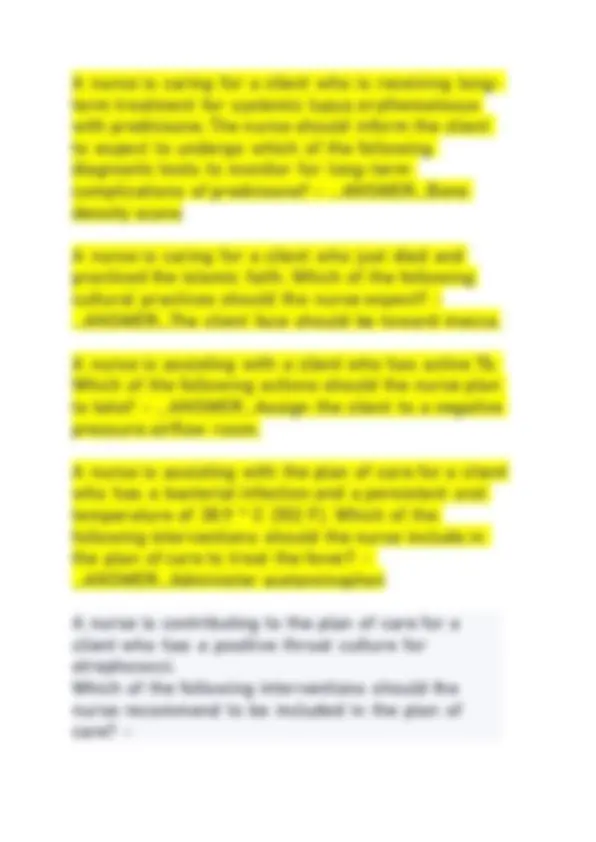
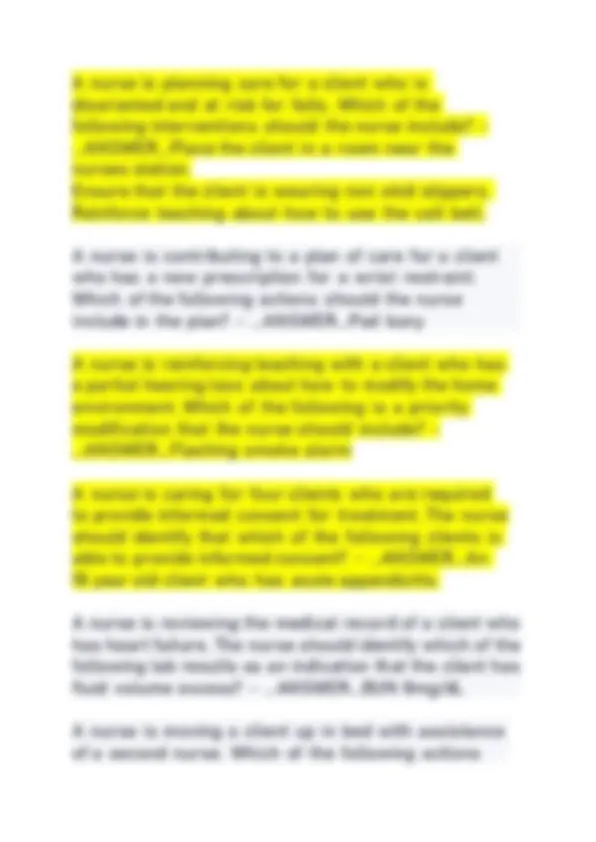
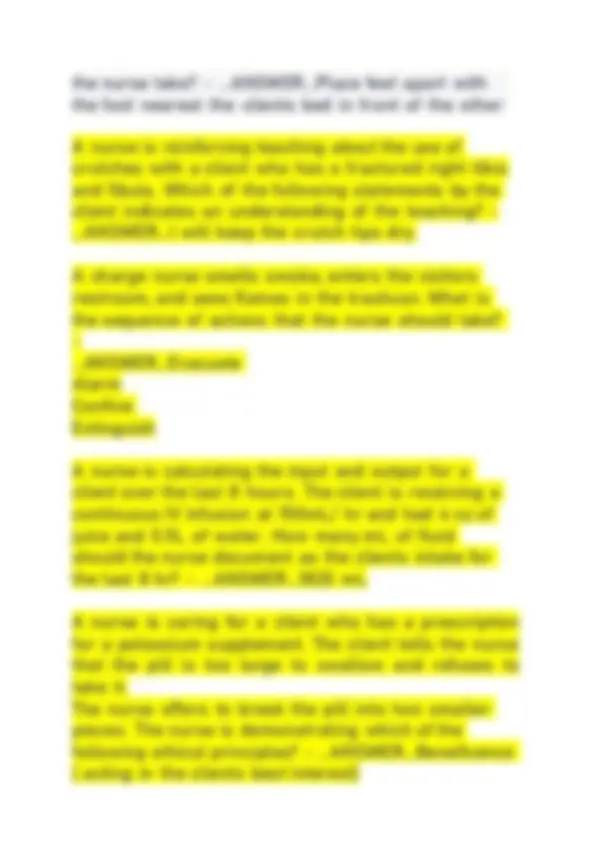
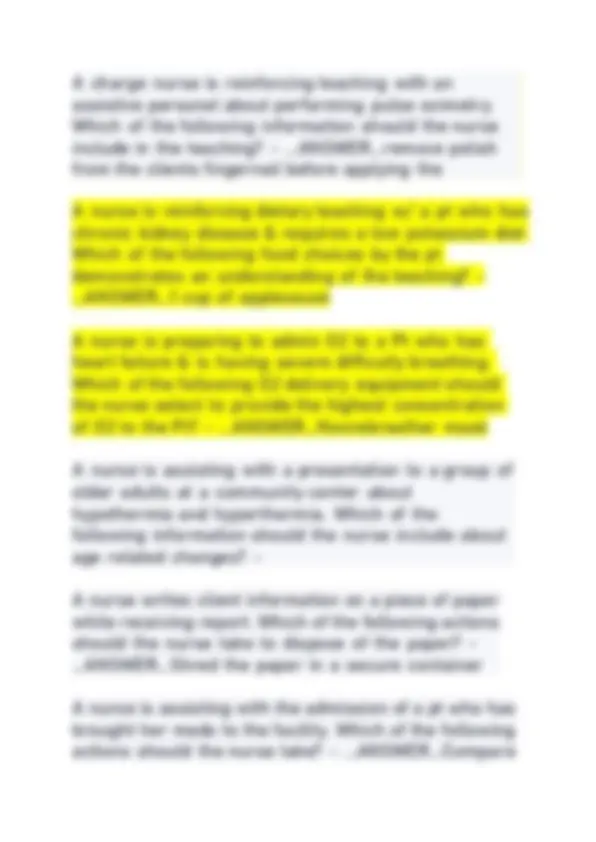
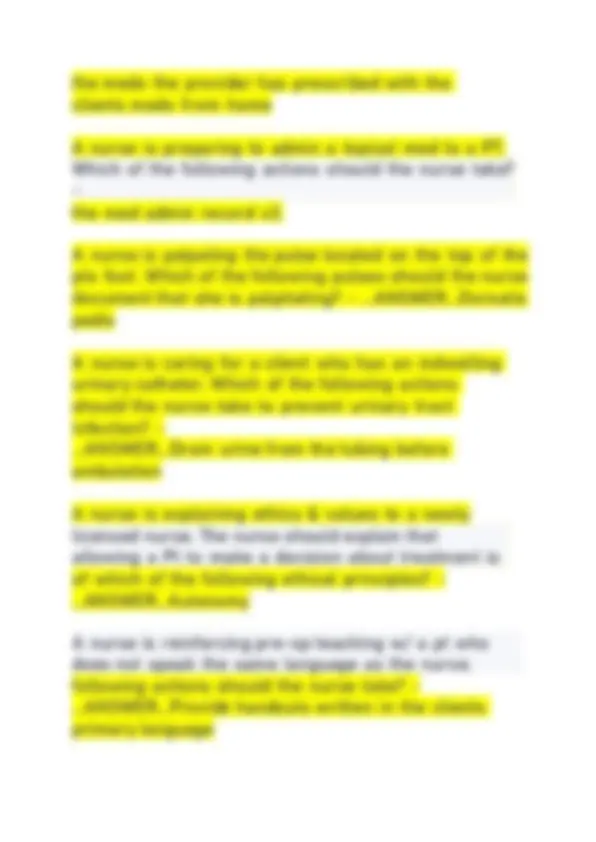
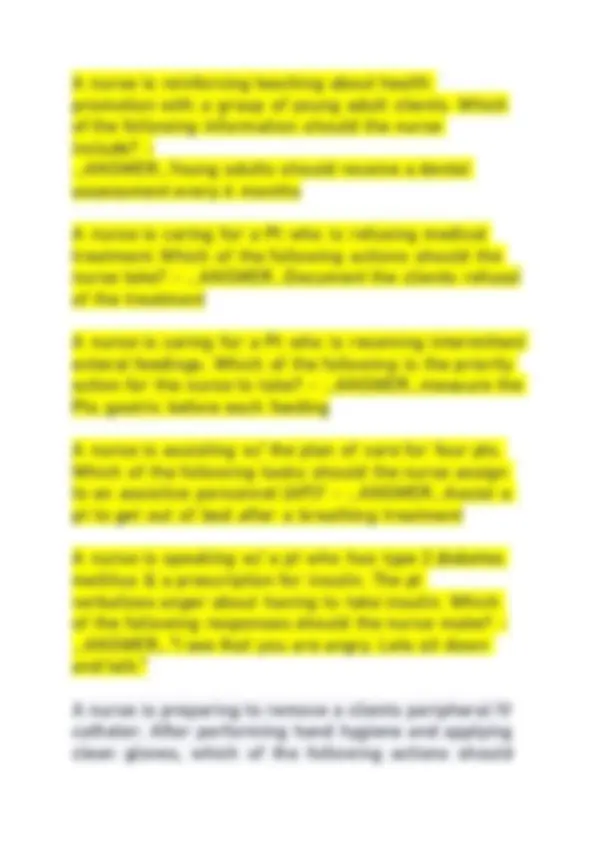
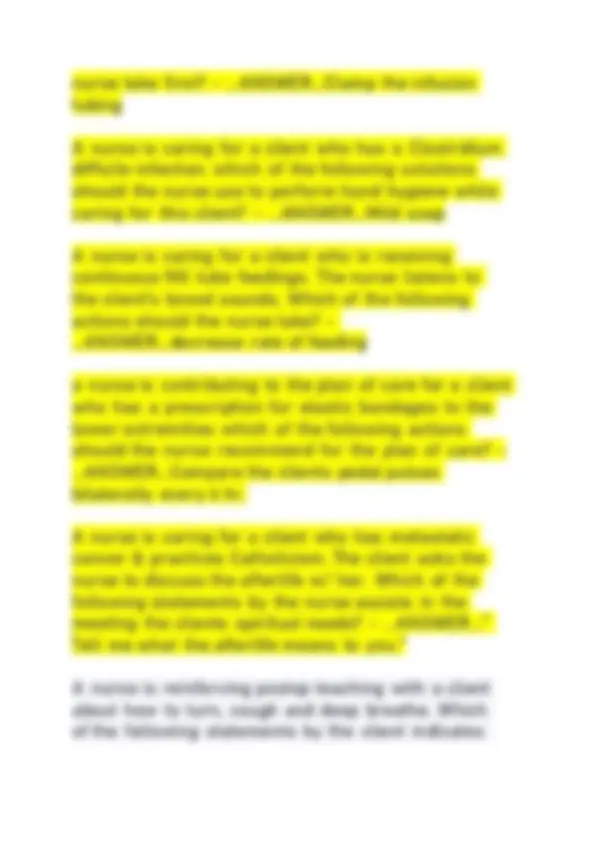
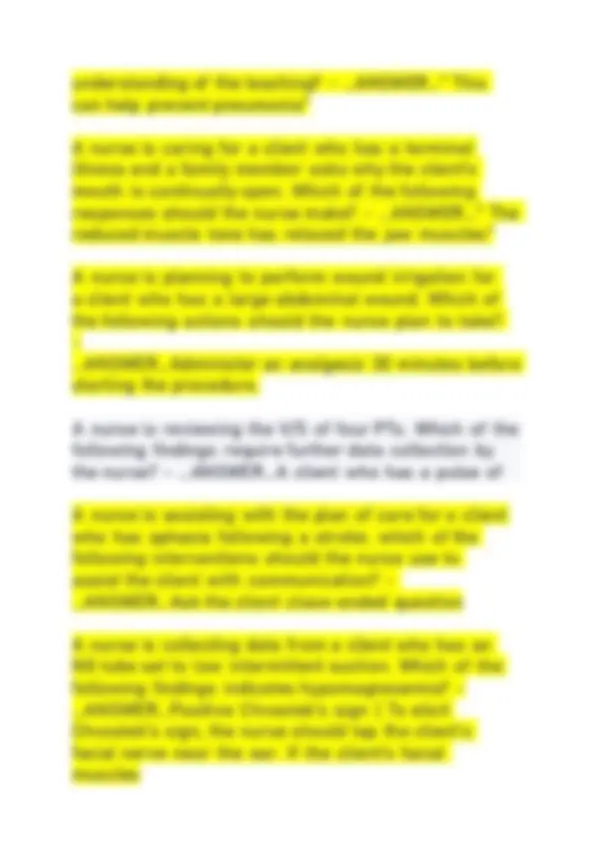
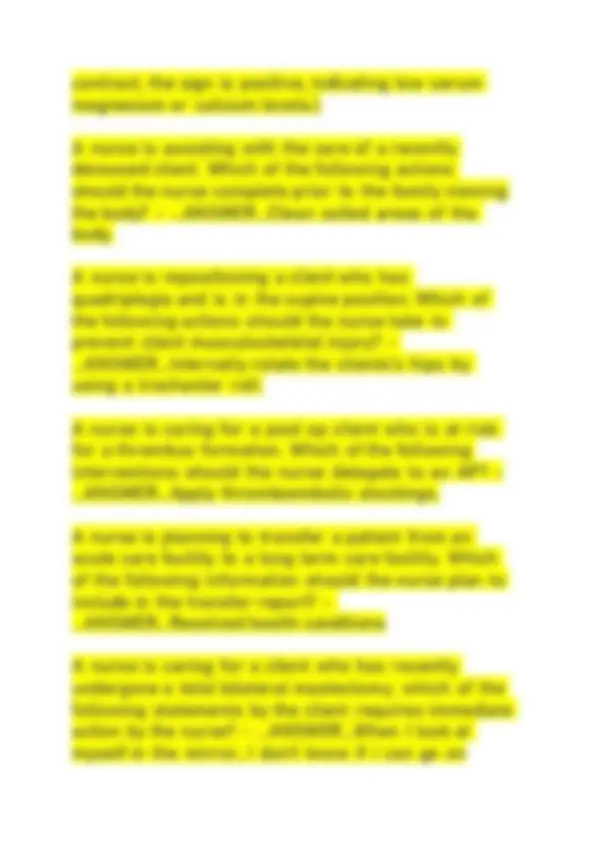
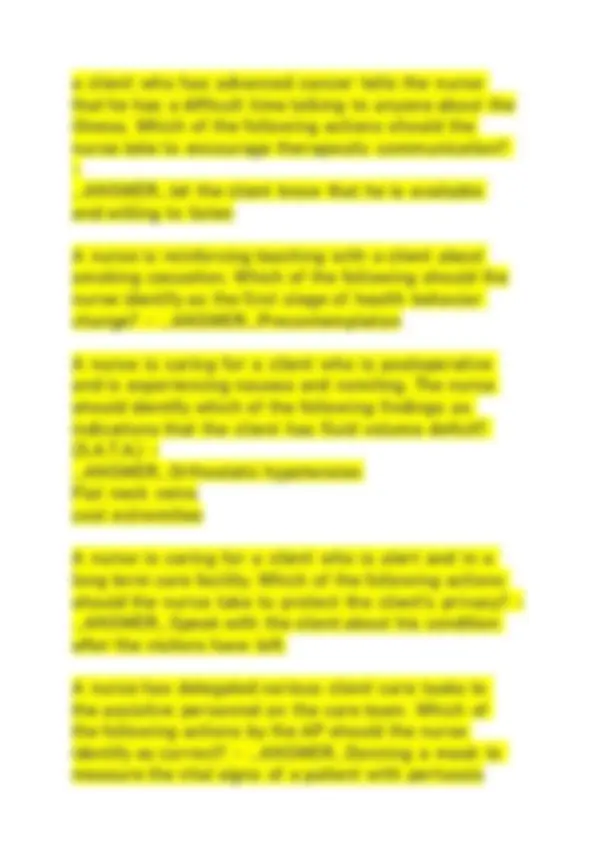
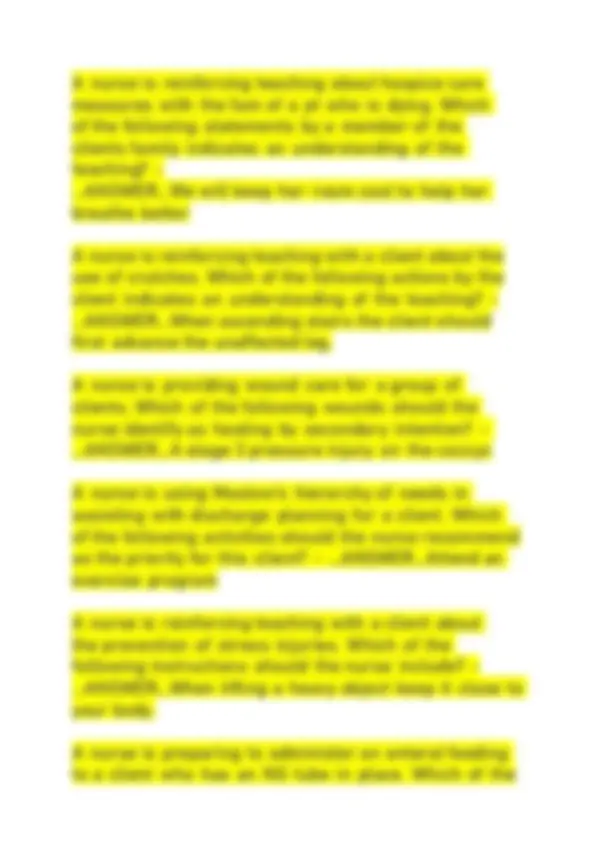
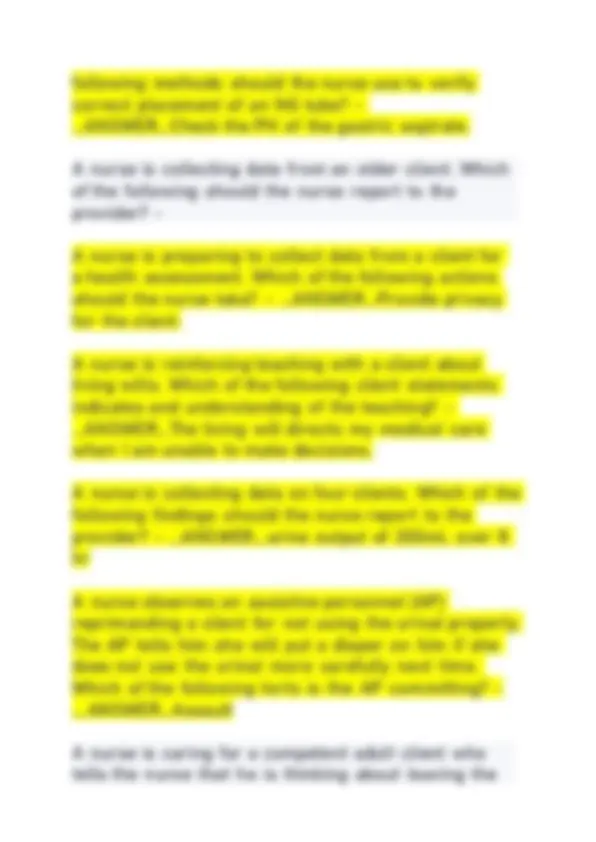
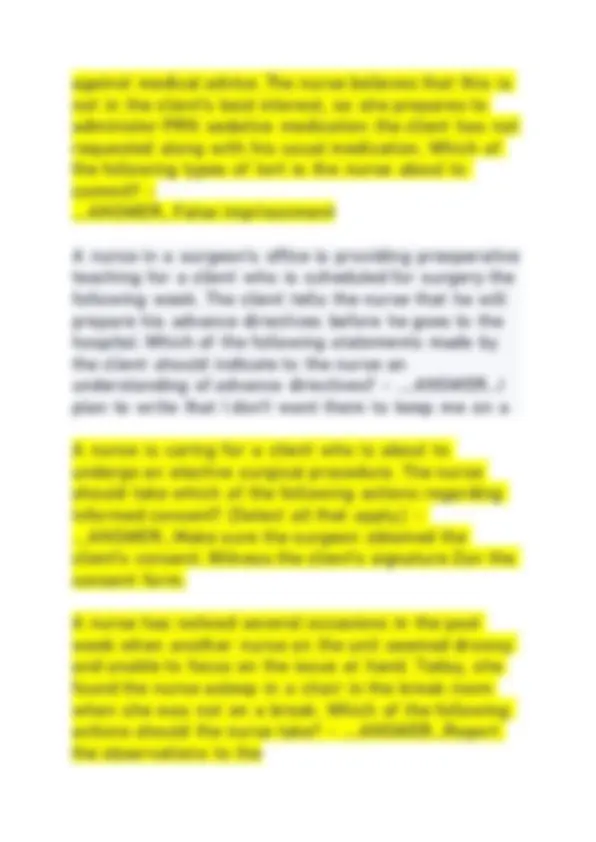
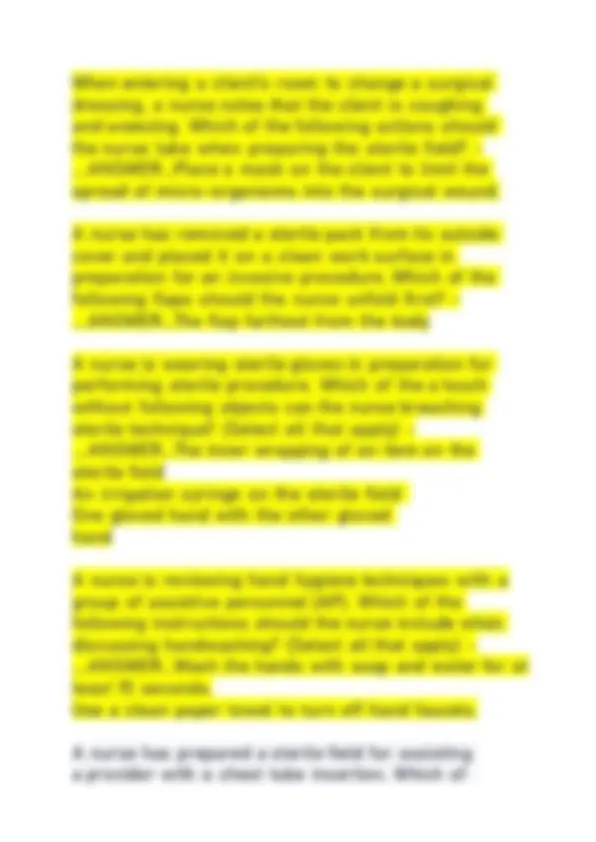
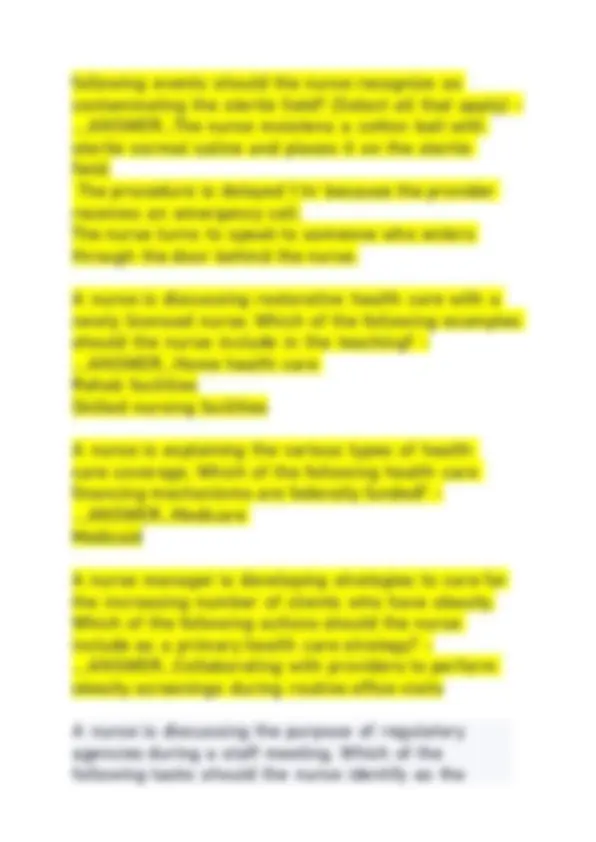
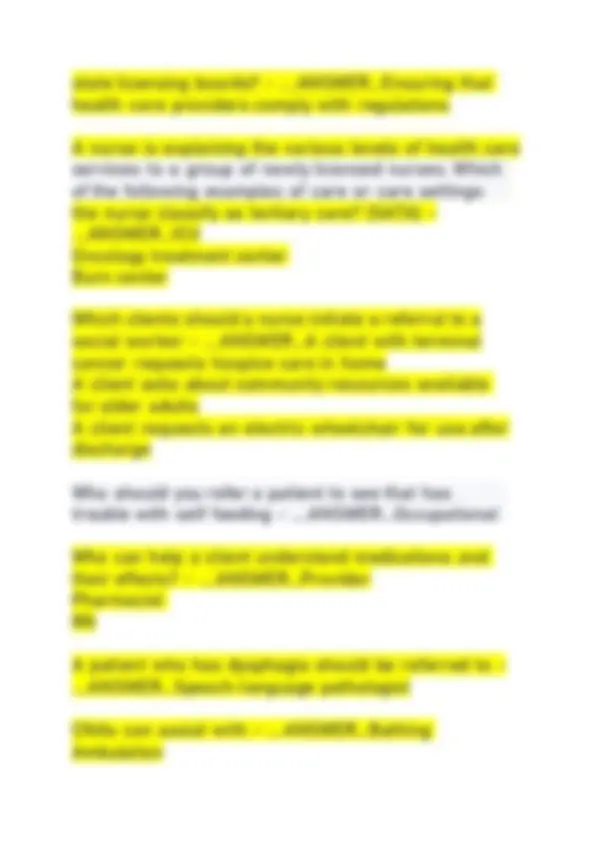
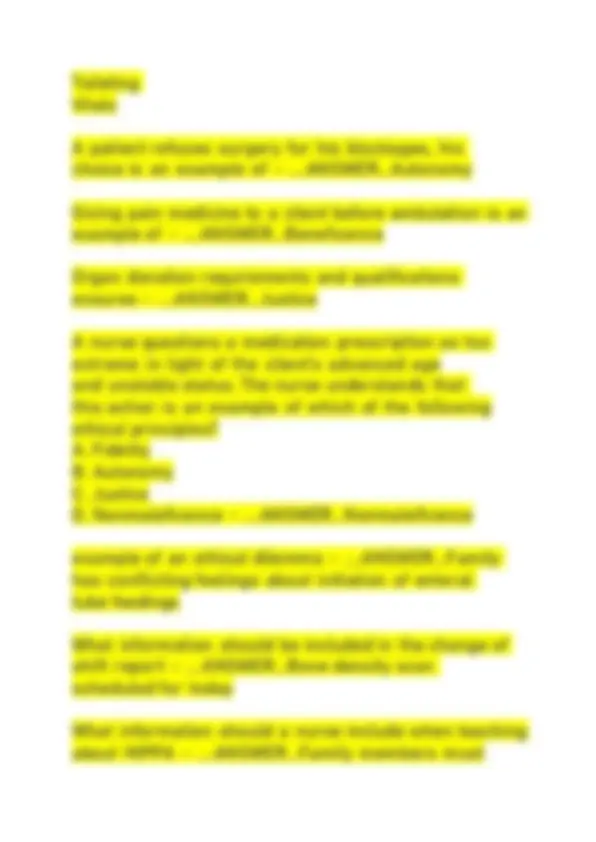
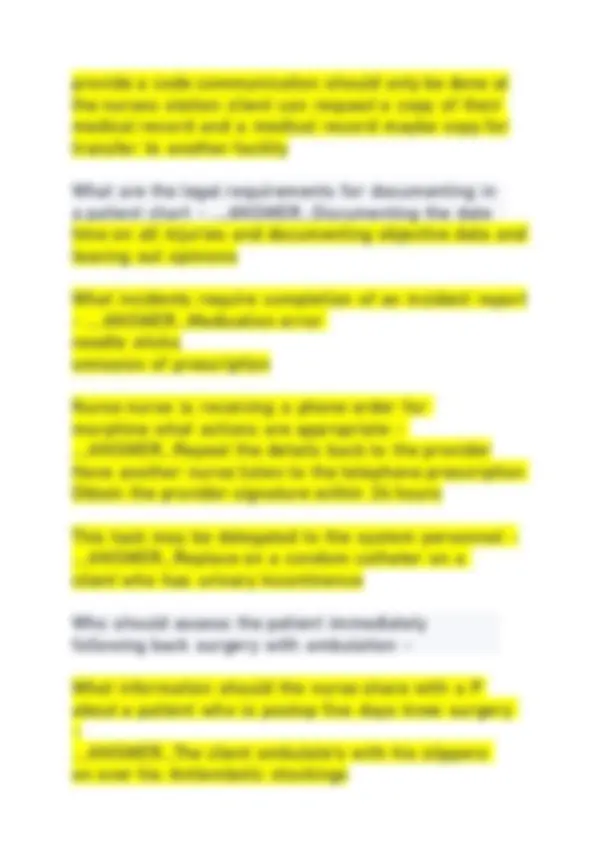
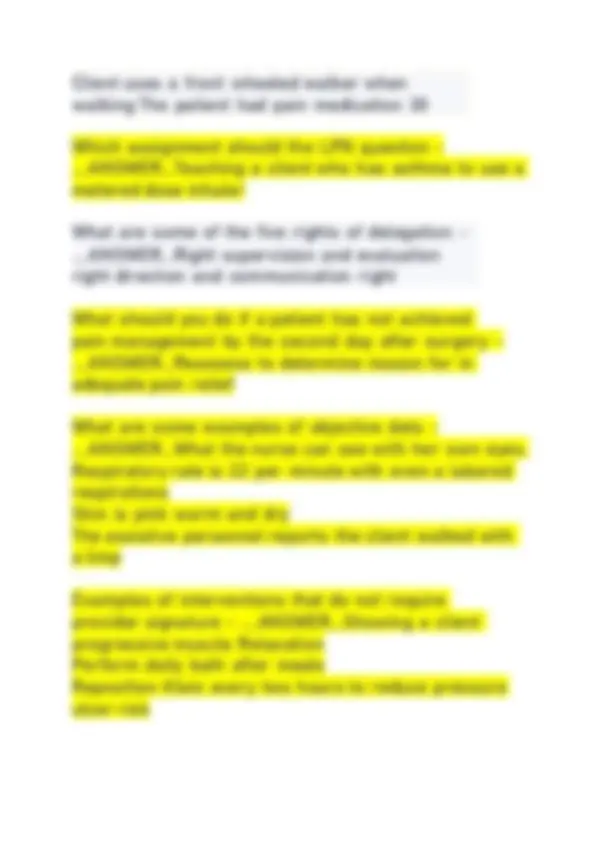
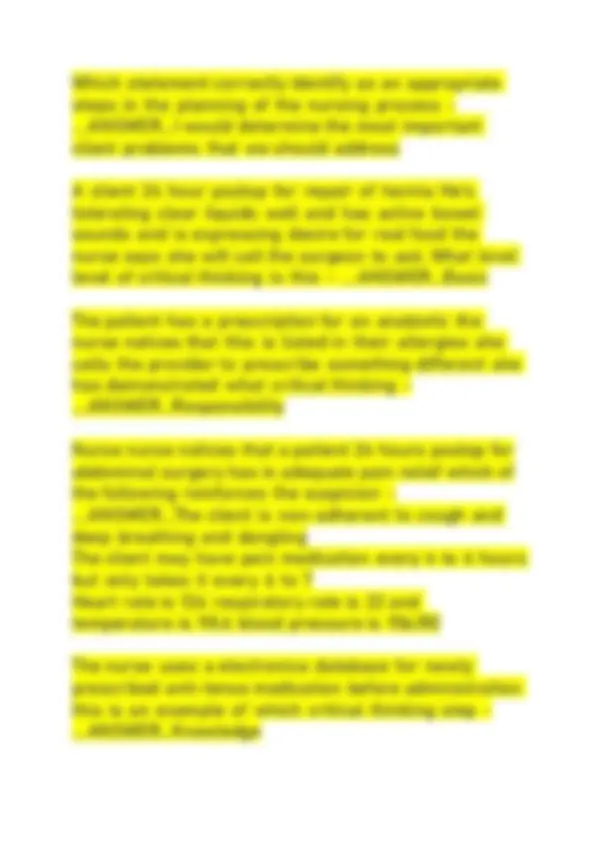
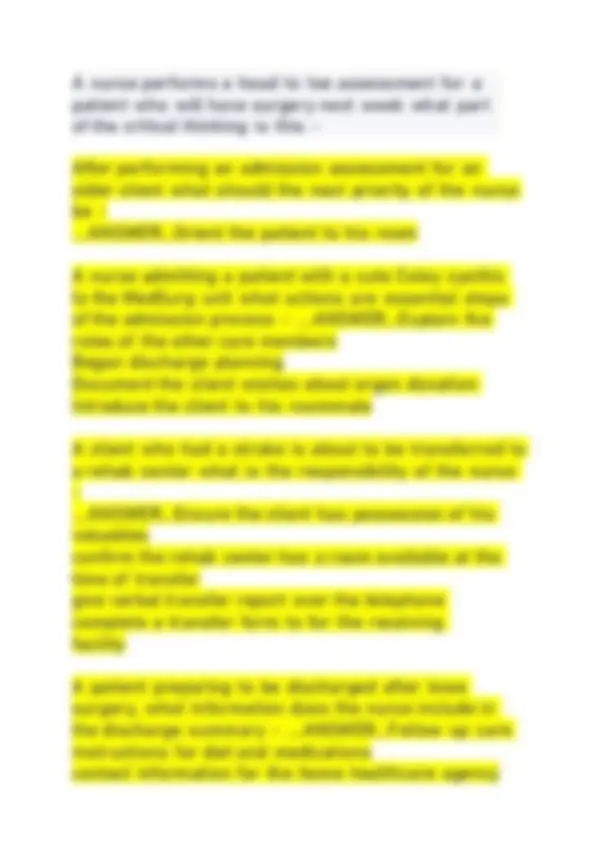
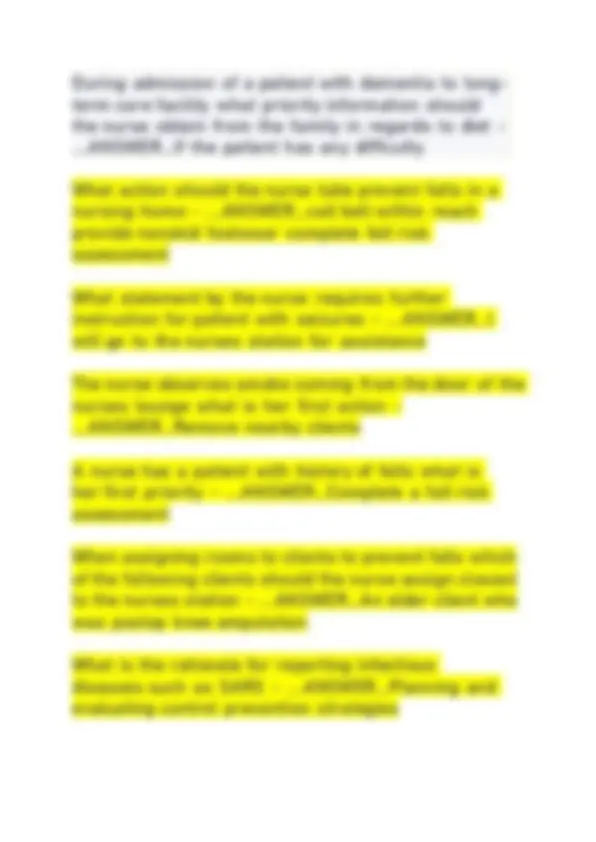
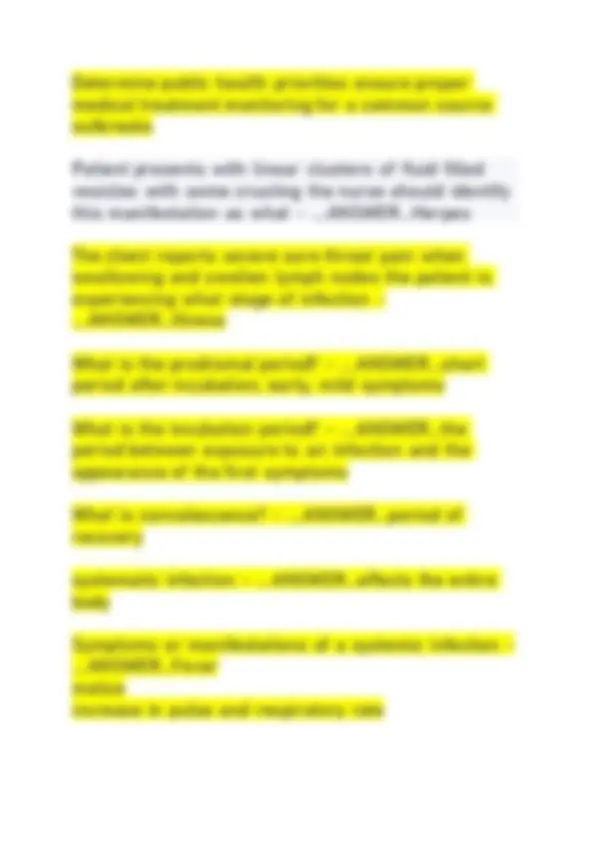
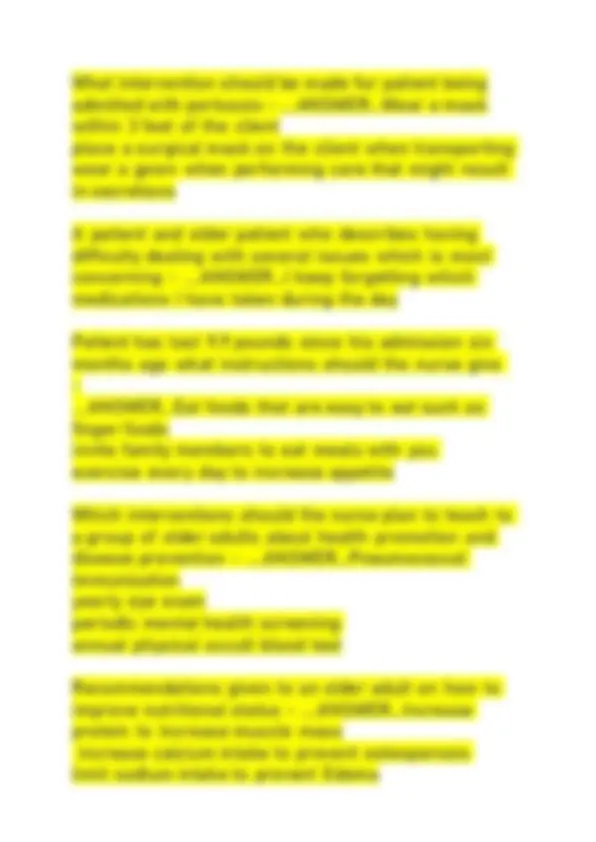
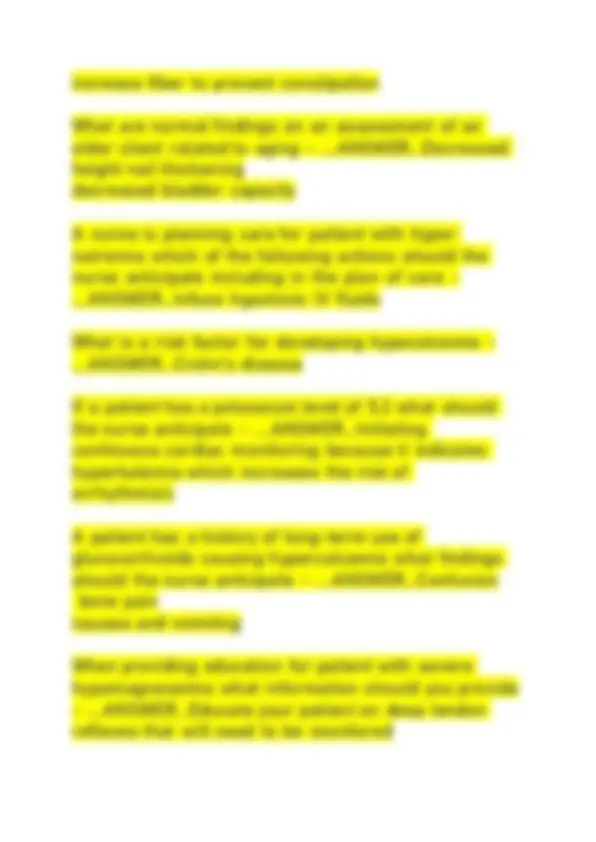
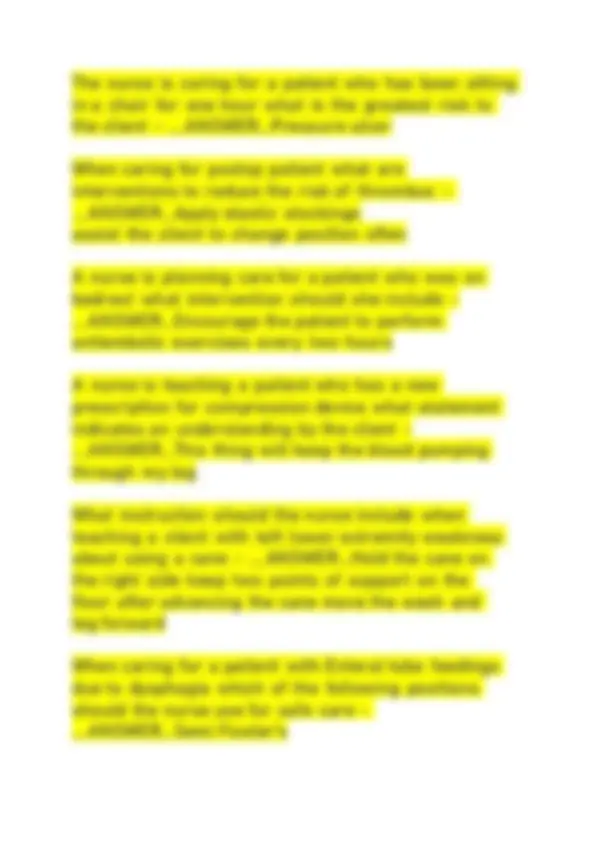
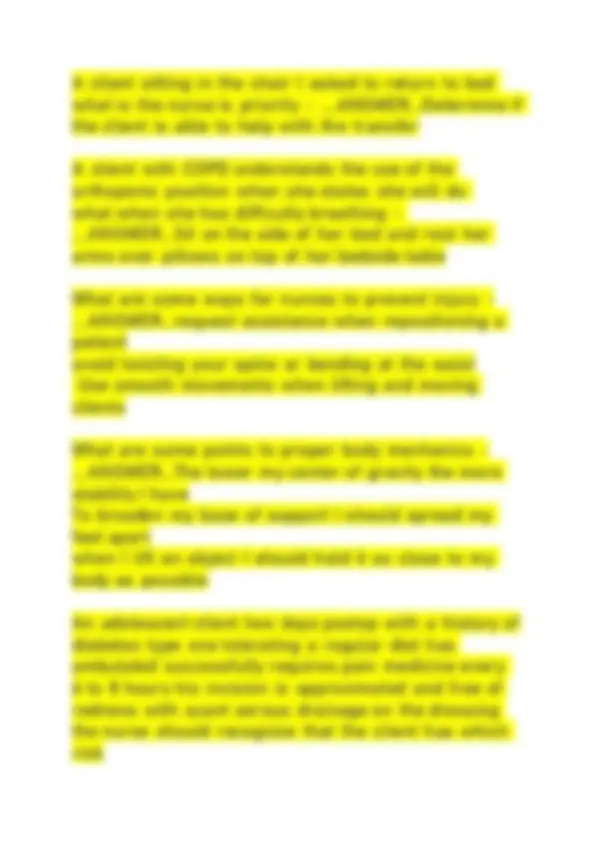
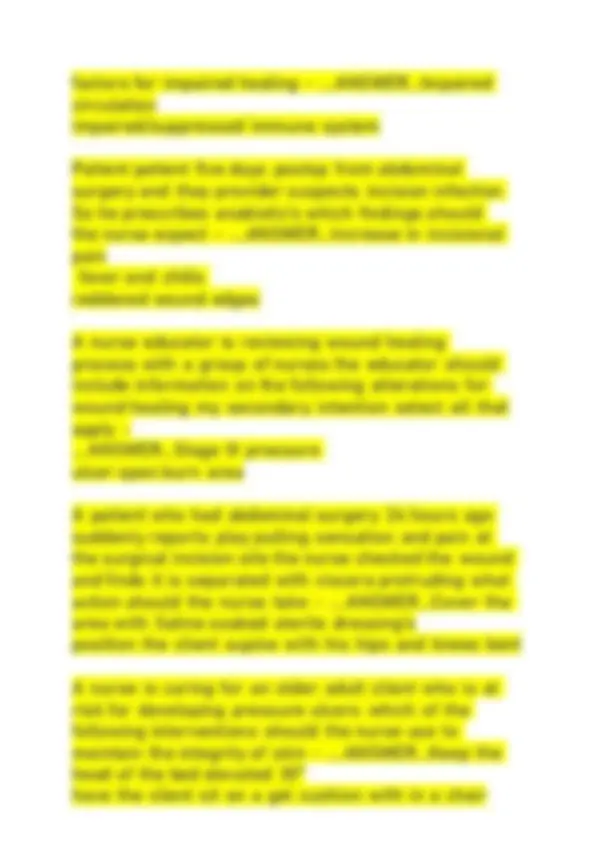
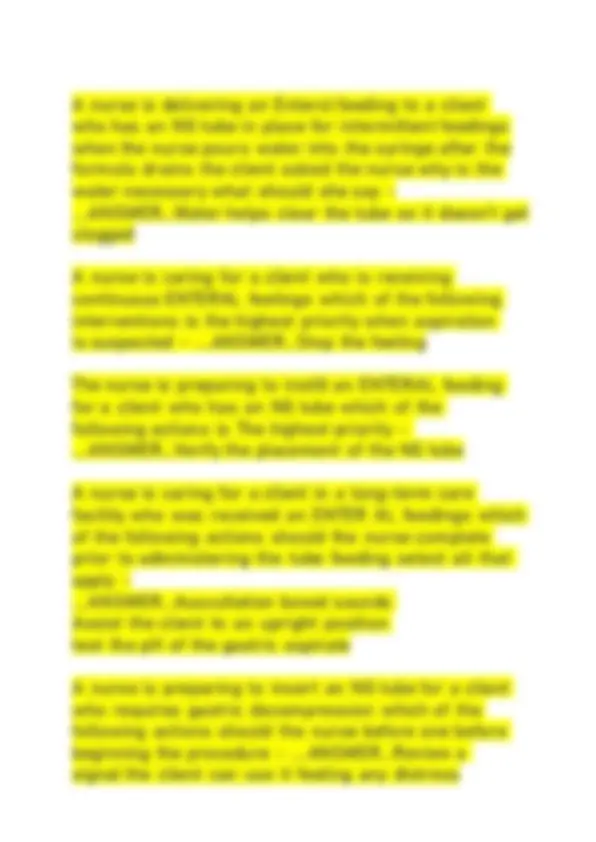
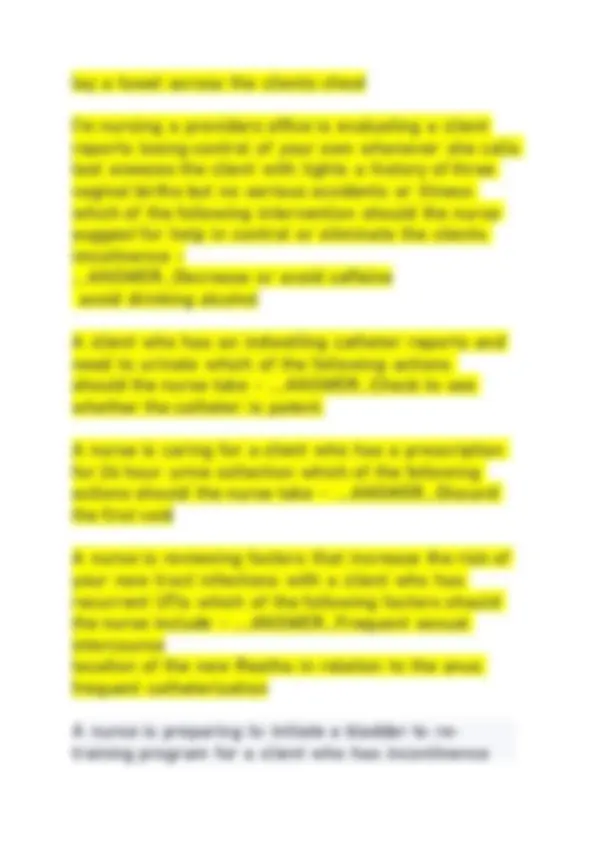
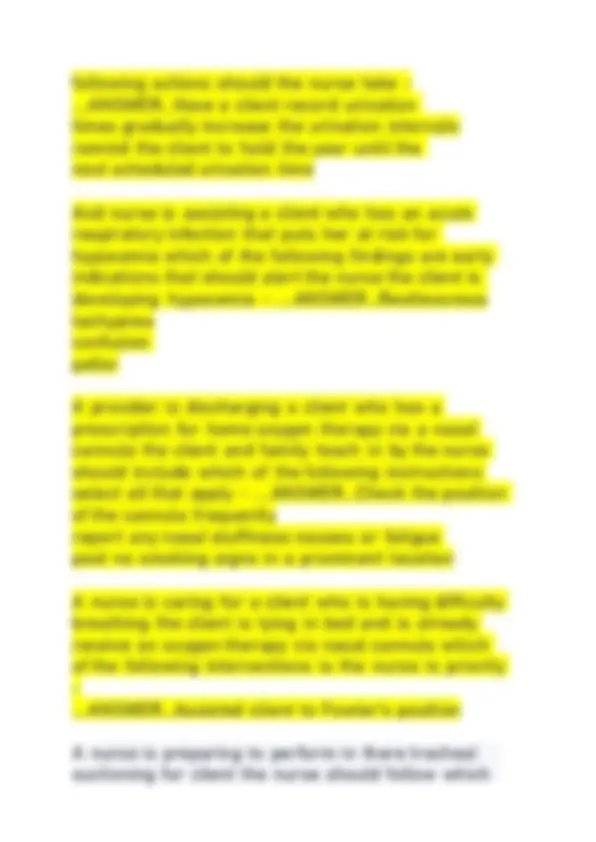
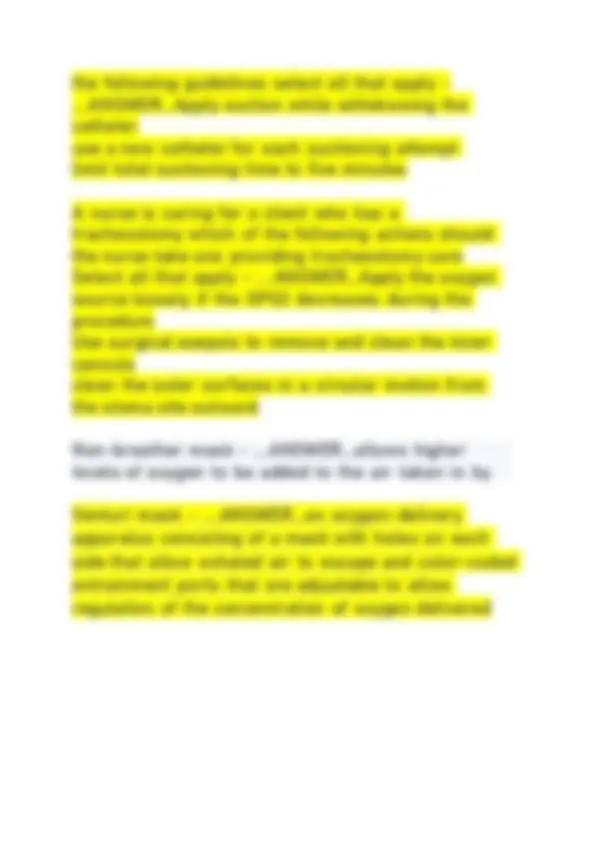


Study with the several resources on Docsity

Earn points by helping other students or get them with a premium plan


Prepare for your exams
Study with the several resources on Docsity

Earn points to download
Earn points by helping other students or get them with a premium plan
Community
Ask the community for help and clear up your study doubts
Discover the best universities in your country according to Docsity users
Free resources
Download our free guides on studying techniques, anxiety management strategies, and thesis advice from Docsity tutors
ATI PN FUNDAMENTALS 2025 EXAM .pdf
Typology: Exams
1 / 78

This page cannot be seen from the preview
Don't miss anything!







































































A nurse is assisting with the admission of a client who has active tuberculosis. Which of the following actions should the nurse plan to take? A. Restrict the client's visitors to the immediate family. B. Assign the client to a negative-pressure airflow room. C. Discard personal protective equipment outside the client's room. D. Have the client wear a HEPA mask during transportation throughout the facility. - ...ANSWER...B. Assign the client to a negative- pressure airflow room. RATIONALE: The nurse should assign the client to a negative-pressure airflow room to ensure that the air from the client's room is not circulated throughout the facility. A nurse is assisting with the plan of care for a client who has a bacterial infection and a persistent oral temperature of 38.9° C (102° F). Which of the following interventions should the nurse include in the plan of care to treat the fever? A. Administer acetaminophen.
B. Apply ice packs to the client's axillae. C. Maintain the room temperature at 18.3° C (64.9° F). D. Assist the client to ambulate four times a day. - ...ANSWER...A. Administer acetaminophen. RATIONALE: The nurse should administer acetaminophen or an NSAID such as ibuprofen to the client to reduce the body's temperature. Acetaminophen inhibits the synthesis of prostaglandins, resulting in a reduced fever. A nurse is contributing to the plan of care for a client who has a positive throat culture for streptococci. Which of the following interventions should the nurse recommend to be included in the plan of care? A. Place the client in a room with another client who has pharyngitis. B. Ensure that the client wears a surgical mask during transportation throughout the facility. C. Limit the client's visitors to visitations of 30 min. D. Provide the client a room with negative-pressure airflow of six air exchanges per hour. - ...ANSWER...B. Ensure that the client wears a surgical mask during transportation throughout the facility. RATIONALE: Streptococcal pharyngitis requires droplet precautions. The nurse should instruct the client to wear a surgical mask when outside of the room to prevent the spread of infection. Staff should make every attempt to limit the client's movement outside of the room.
C. Remove the restraint every 4 hr to allow movement. D. Tie the restraint with a knot that will tighten when pulled. - ...ANSWER...B. Pad bony prominences on the wrist. RATIONALE: The nurse should pad bony prominences on the wrist to prevent skin breakdown caused by the restraint rubbing against the client's skin. A nurse is reinforcing teaching with a client who has a partial hearing loss about how to modify the home environment. Which of the following is a priority modification that the nurse should include? A. Alarm clock that shakes the bed B. Flashing smoke alarm C. Low-pitched buzzer doorbell D. Telephone with an amplified receiver - ...ANSWER...B. Flashing smoke alarm RATIONALE: The greatest risk to the client's safety is injury from a fire. Therefore, the priority modification is to install flashing smoke alarms because this allows the client to see when the alarm is activated rather than having to hear it. A nurse is caring for four clients who are required to provide informed consent for treatment. The nurse should identify that which of the following clients is able to provide informed consent? A. A client who is receiving opioid medications via a PCA pump B. A client who has moderate Alzheimer's disease
C. An 18 - year-old client who has acute appendicitis D. A 16 - year-old client who has a fractured tibia - ...ANSWER...C. An 18 - year-old client who has acute appendicitis RATIONALE: A competent 18 - year-old client who has acute appendicitis is able to provide informed consent for treatment. A nurse is reviewing the medical record of a client who has heart failure. The nurse should identify which of the following laboratory results as an indication that the client has fluid volume excess? A. Urine specific gravity 1. B. Hematocrit 42% C. Urine pH 6. D. BUN 8 mg/dL - ...ANSWER...D. BUN 8 mg/dL RATIONALE: A BUN of 8 mg/dL is below the expected reference range of 10 to 20 mg/dL. With fluid volume excess, the nurse should expect the client's BUN to be below the expected reference range due to hemodilution. A nurse is moving a client up in bed with the assistance of a second nurse. Which of the following actions should the nurse take? A. Stand facing the center of the bed at the client's side. B. Place feet apart with the foot nearest the head of the client's bed in front of the other foot. C. Keep knees and hips straight while bending at the waist toward the client.
A nurse is caring for a client who has a prescription for a potassium supplement. The client tells the nurse that the pill is too large to swallow and refuses to take it. C. Evacuate clients from the area. D. Pull the lever on the fire alarm box. - ...ANSWER...C. Evacuate clients from the area. The first action the nurse should take when using the RACE protocol is to "rescue" or evacuate the clients from the area to prevent harm. D. Pull the lever on the fire alarm box. For the next step, "alarm," the nurse should activate the facility fire alarm and call to report the fire to the facility emergency extension. A. Close the fire doors on the unit. For the third step, "confine," the nurse should close the unit fire doors to prevent the fire from spreading. B. Use a fire extinguisher to put out the fire. For the final step, "extinguish," the nurse should use a fire extinguisher to put out the fire by aiming the nozzle at the base of the fire and using a sweeping motion. A nurse is calculating the intake and output for a client over the last 8 hr. The client is receiving a continuous IV infusion at 150 mL/hr and had 4 oz of juice and 0.5 L of water. How many mL of fluid should the nurse document as the client's intake for the last 8 hr? (Round your answer to the nearest whole number.) mL - ...ANSWER...1820 mL
The nurse is demonstrating beneficence by acting in the client's best interest to make it possible for the client to A charge nurse is reinforcing teaching with an assistive personnel (AP) about performing pulse oximetry. Which The nurse should instruct the AP to remove the client's fingernail polish on at least one finger before placing the probe on that finger because the sensor needs to detect a pulsating vascular bed to produce a reading. The nurse offers to break the pill into two smaller pieces. The nurse is demonstrating which of the following ethical principles? A. Autonomy B. Beneficence C. Justice D. Nonmaleficence - ...ANSWER...B. Beneficence swallow the medication. of the following information should the nurse include in the teaching? A. Select an alternate site to place the oximetry probe if the capillary refill is less than 2 seconds. B. Use an adhesive oximetry probe for a client who has a latex allergy. C. Remove polish from the client's fingernail before applying the oximetry probe. D. Lubricate the tip of the oximetry probe. - ...ANSWER...C. Remove polish from the client's fingernail before applying the oximetry probe.
A nurse is assisting with a presentation to a group of older adults at a community center about hypothermia A. Body regulation of heat and cold increases with age. B. Circulation becomes less efficient with age. C. Increased metabolic rate occurs with age, increasing body temperature. D. Sweat gland activity is increased with age. - ...ANSWER...B. Circulation becomes less efficient with age. Older adults have an increased sensitivity to temperature extremes due to decreased cardiac output. Poor cardiac output leads to less efficient circulation of blood to the tissues. A nurse is taking notes of client information on a piece A. Obscure the client's name with a marker prior to disposal. B. Place the paper in a trash can at the nurses' station. C. Shred the paper in a secure container. D. Secure the paper in the nurse's personal locker. - ...ANSWER...C. Shred the paper in a secure container. The nurse should shred any written information in a secure container after use to protect the client's privacy and adhere to HIPAA guidelines. and hyperthermia. Which of the following information should the nurse include about age- related changes? of paper while receiving report. Which of the following actions should the nurse take to dispose of the paper?
A nurse is assisting with the admission of a client who has brought their medications to the facility. Which of the following actions should the nurse take? A. Allow the client to continue taking the medications as they did at home. B. Take the medications from the client and discard them. C. Compare the medications the provider has prescribed with the client's medications from home. D. Place the medications in the medication cart and administer them as the client took them at home. - ...ANSWER...C. Compare the medications the provider has prescribed with the client's medications from home. During admission, the nurse should compare the medications that the provider has prescribed with the medications that the client is taking at home to decrease the risk of medication error. The nurse should include this information in the client's medical record as a resource for other health care personnel. A nurse is preparing to administer a topical medication to a client. Which of the following actions should the nurse take? A. Show the assistive personnel where to apply the medication. B. Ask the client when the previous nurse last applied the medication. C. Identify the client by comparing the medication administration record with the client's room number.
Draining urine from the tubing before ambulation will prevent backflow of urine into the bladder. A nurse is explaining ethics and values to a newly licensed nurse. The nurse should explain that allowing a client to make a decision about a treatment is an example of which of the following ethical principles? A. Confidentiality B. Nonmaleficence C. Accountability D. Autonomy - ...ANSWER...D. Autonomy Autonomy is an ethical principle that refers to protecting a client's independence and right to make decisions about care. A nurse is reinforcing preoperative teaching with a client who speaks a different language than the nurse. Which of the following actions should the nurse take? A. Ask a family member who speaks the client's primary language to interpret. B. Plan a long teaching session initially to introduce the necessary material. C. Provide the least important information first. D. Provide handouts written in the client's primary language. - ...ANSWER...D. Provide handouts written in the client's primary language. The nurse should provide handouts that are easy to read in the client's primary language to promote learning.
A nurse is reinforcing teaching about health promotion with a group of young adult clients. Which of the following information should the nurse include? A. Young adults should receive a dental assessment every 6 months. B. Young adult males should have a testicular examination every 5 years. C. Young adult females should have a routine physical examination every 4 years. D. Young adults should receive a tuberculosis skin test every 3 years. - ...ANSWER...A. Young adults should receive a dental assessment every 6 months. The nurse should include the recommendation for young adults to receive a dental assessment twice per year. A nurse is caring for a client who is refusing medical treatment. Which of the following actions should the nurse take? A. Explain the negative consequences of the refusal. B. Discuss with the client's partner why the treatment is necessary. C. Document the client's refusal of the treatment. D. Try to convince the client that the treatment is needed. - ...ANSWER...C. Document the client's refusal of the treatment. The nurse is responsible for notifying the provider when a client refuses a treatment or procedure and documenting the client's decision.
This is an example of the therapeutic communication technique of offering self. It provides an opportunity for the nurse to understand the reason for the client's anger and provides a means for further communication. The nurse should instruct the client to keep the object as close to their body as possible to increase stability and decrease back strain when lifting a heavy object. A nurse is speaking with a client who has type 2 diabetes mellitus and a prescription for insulin. The client verbalizes anger about having to take insulin. Which of the following responses should the nurse make? A. "Why are you angry about taking insulin?" D. "You should take insulin, because it reduces the risk for complications." - ...ANSWER...C. "I see that you are angry. Let's sit down and talk." A nurse is reinforcing teaching with a client about the prevention of stress injuries. Which of the following instructions should the nurse include? A. "Keep your knees in a locked position when standing for prolonged periods." B. "Bend at the waist when lifting a heavy object." C. "Keep your feet close together when lifting a heavy object." D. "When lifting a heavy object, keep it close to your body." - ...ANSWER...D. "When lifting a heavy object, keep it close to your body." B. "Don't worry. Diabetes runs in my family as well." C. "I see that you are angry. Let's sit down and talk."
A nurse is providing wound care for a group of clients. Which of the following wounds should the nurse identify as healing by secondary intention? A. A stage 3 pressure injury on the coccyx B. A contaminated wound that is closed after 72 hr C. A puncture wound that is sutured D. An abdominal surgical wound with intact staples - ...ANSWER...A. A stage 3 pressure injury on the coccyx The nurse should identify a pressure injury and other wounds with edges that are not approximated as healing by secondary intention. A nurse is reinforcing teaching with a client about living wills. Which of the following client statements indicates an understanding of the teaching? A. "The living will directs my medical care when I am unable to make decisions." B. "I should have a nurse cosign my living will." C. "After signing the living will, I will not be able to make any changes." D. "I am required by Medicare to have a living will when I am admitted to the hospital." - ...ANSWER...A. "The living will directs my medical care when I am unable to make decisions." The living will provides specific directions for a client's medical treatment when the client is unable to make decisions due to their health status.
A nurse is reinforcing teaching with a client about the use of crutches. Which of the following actions by the client indicates an understanding of the teaching? A. The client leans on the crutches for support while standing still. B. The client advances the unaffected leg first while climbing stairs. C. The client stands 5 cm (2 in) from the front of a chair before sitting. D. The client bears weight on their axilla while standing in the tripod position. - ...ANSWER...B. The client advances the unaffected leg first while climbing stairs. When ascending stairs, the client should first advance the unaffected leg. A nurse is preparing to collect data from a client for a health assessment. Which of the following actions should the nurse take? A. Provide privacy for the client. B. Keep the lights at a dim level. C. Expose half of the body at a time. D. Encourage the client's friend to remain in the room.
...ANSWER...A. Provide privacy for the client. The nurse should promote a therapeutic environment by providing privacy while data is being collected for a health assessment. A nurse is collecting data from an older adult client. Which of the following findings should the nurse report to the provider?
Following death, it can be a practice of the Islamic faith to turn the face of a deceased person toward Mecca. A. The client has smooth, brown, irregular lesions on the back of each hand. B. The client has glossy, white circles around the periphery of the corneas. C. The client reports urinary incontinence. D. The client reports a decreased sense of taste. - ...ANSWER...C. The client reports urinary incontinence. Aging is a risk factor for urinary incontinence as older adult males can experience hypertrophy of the prostate gland, and older adult females can experience stress incontinence with laughing, sneezing, or coughing. Urinary incontinence is an abnormal condition that can impact the quality of life for older adults. Urinary incontinence should be investigated; therefore, the nurse should report this finding to the provider. Interventions can be reinforced to the client to promote improved urinary function. A nurse is caring for a client who has just died and practiced the Islamic faith. Which of the following cultural practices should the nurse expect? A. The client's body should be placed on the floor. B. The client's oldest child will bathe the body. C. The client's face should be turned toward Mecca. D. The client's body will be adorned with amulets. - ...ANSWER...C. The client's face should be turned toward Mecca.